Today, we go up to Machu Picchu!
So, of course I am awake an hour before our wake up call is due! Isn’t that always the way? I took the opportunity of being up stupid early to catch up with the family back home in Australia… I’ve been gone for two months and I am missing them terribly, so it was wonderful to have some hotel wifi.
When the sun did come up – what a beautiful surprise… Aguas Callientes is very happily situated straddling a ravine that is effectively the valley between several beautiful high mountains that tower over the village. We couldn’t really make out the mountains on our little walk around last night in the dark, and so we were greeted with a beautiful view from the hotel over the rooftops of the town this morning.


Before long it was time to get dressed and head down for breakfast – another lovely spread of everything you could possibly want… fruits, pastries, cheeses, pancakes, waffles, cold meats, eggs, omelettes, fruit juices, tea and coffee, you name it. Fortified by some fruit, a boiled egg and a cup of tea, we went for a short walk around to see Aguas Callientes in the day light. The weather was cool but not cold, and I needed only a light scarf over my linen shirt, and the town seemed still very much asleep at 07:00. We walked over the one of the bridges that traverses the ravine, did a walk through the markets that were not yet open and wandered down the Main Street. It really is a beautiful little village. I could imagine spending a couple of days here without any problem.


But, we had places to go and things to do – so back to the hotel by 07:30 so we could walk around the corner and catch a bus up to Machu Picchu. We were in luck, the line for the bus was non-existent, though Jaime told us last July and August, the lines were horrendous – up to two hours wait to get a bus to take you to the site. The problem is that the site is made to accommodate about 2000 tourists a day, which is quite a lot… but seeing that Machu Picchu is on every serious travellers’ “Bucket List” it has become a very popular destination and last year they were seeing as many as 5400 people going through the site on busy days in July and August. Jaime said he felt this was no way to see this spiritual place, crammed in like sardines, and cheek to jowl with so many other people all trying to use the narrow steps and pathways. Today, he estimated that maybe only 900-1000 people would be visiting… the low season here runs December/January through to March and the number of visitors starts to pick up in April to September (the northern hemisphere’s summer holiday periods). So we were here at a good time of year.
 Our fearless leader, Jaime…
Our fearless leader, Jaime…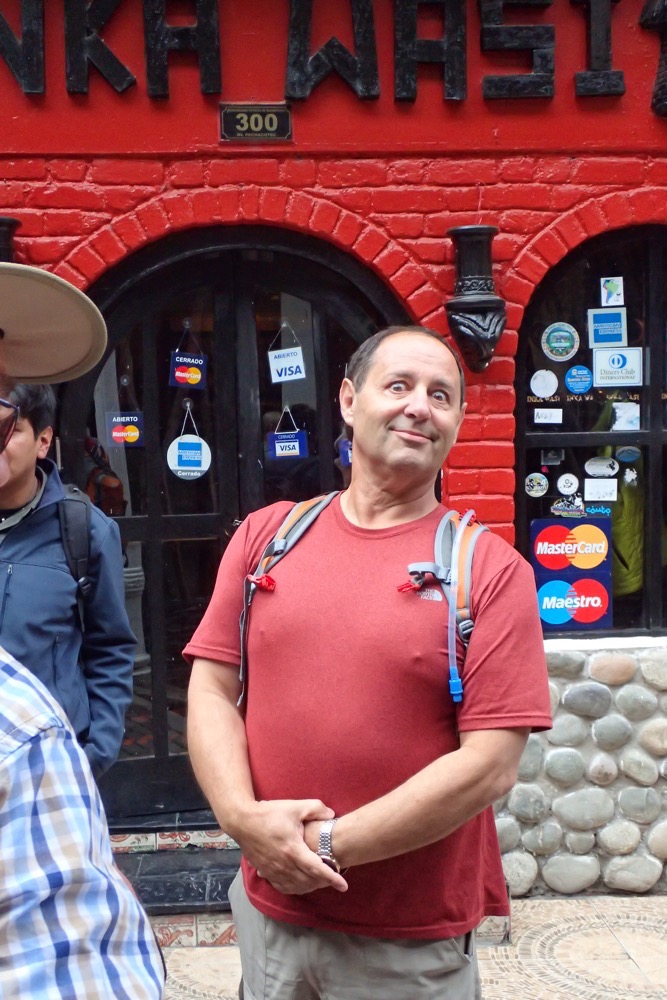
The drive up on the bus was… err ‘interesting’. We couldn’t see much of the landscape above us as it was largely still hidden in the clouds, but we sure could see the sheer drop off the side of the road should our driver prove not as skilful as we all hoped he was! At this point the scenery was quite pretty – beautiful mountains topped by clouds, with the sun struggling to shine though, and lush rainforest surrounding us everywhere.

Thankfully the bus made it to the top of the mountain without incident, and we arrived on site around 08:00. Again we were greeted by that most auspicious of tourist phenomena – no queues! And it was passports and tickets out… I have no idea why, but the hotel, the bus, the train, the national park – they all want your passports all the time and we seem to have spent and inordinate amount of time pulling out and putting away our passports. We proceeded straight into the site whereupon we encountered a stone track with lots of stairs that wound upwards, ever upwards. Jaime had said, ‘We have a walk up of about 20 minutes, and then it will be hours of wandering gently down, down as we do a big circular to the bottom of the site.’ I trusted that his description was accurate.


Twenty minutes sounded ok, and I’m thinking … I’m ready for this, having avoided the elevators as much as possible, I’ve been walking the stairs in the cruise ship to be prepared for this for the last two months! I was glad I had been doing the stairs, I am sure it would have been even worse if I hadn’t done that but it was still a strenuous walk up very uneven steps at roughly 7000 ft elevation. Being a seaside dweller I was really feeling it – heart rate racing within minutes, laboured breathing and frequently stopping… and I’m roughly 20-30 years younger than the rest of my group! I have no idea how they were managing, but I have nothing but admiration for every single one of them who made their way up that hike this morning with various bung knees, bad backs, asthma, sinus problems, and lord knows what else – talk about a great bunch of troopers!


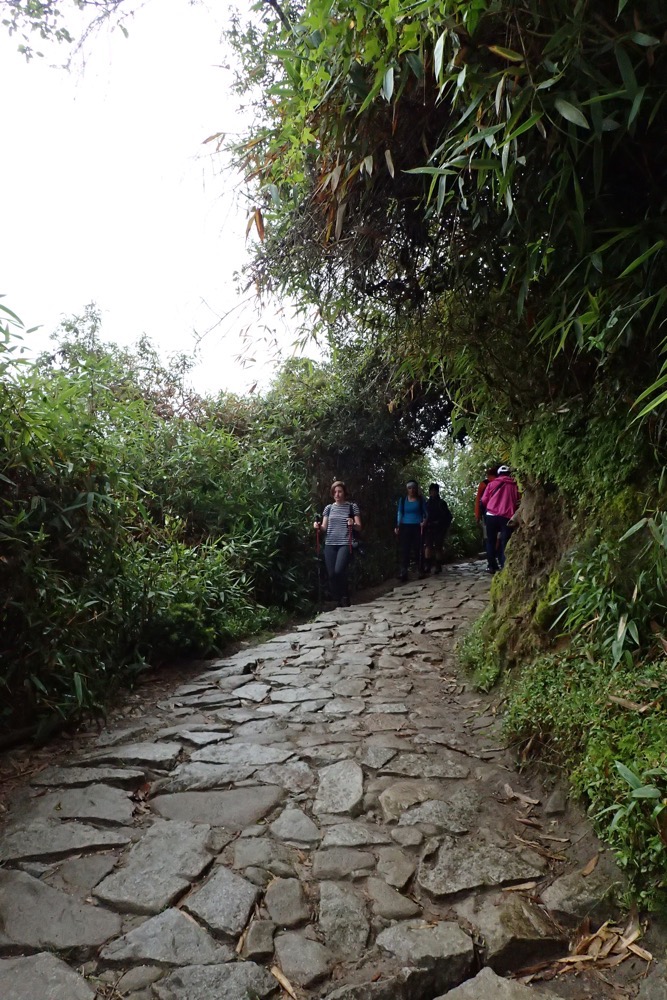
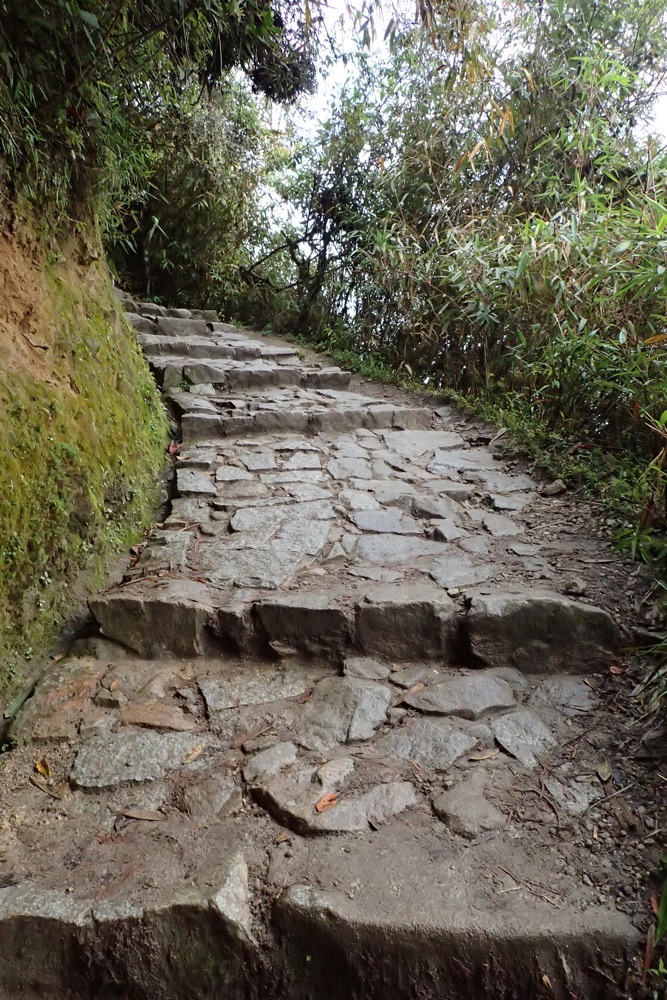
Eventually we finish our climb to ‘The Spot’, where we came out of the bushes and found ourselves looking down at ‘Postcard Machu Picchu’. We were still up in the clouds and fog and watching the ever changing scene below us was amazing. One moment the clouds were covering the site, and moments later, the clouds would move and a beautiful vista unfolded in front of you. It was pure magic! It is hard to describe the immense grandeur and beauty of this place and how seeing it all in front of you, and drinking it all in, affects you. I don’t think there was a single one of us, who didn’t feel moved in some way by the experience.
 Most archeologists agree that Machu Pichhu is a 15th century Inka city that was built as a royal retreat for the Inka King, Pachacutek. It was often called the “Lost City of the Incas”, though that name was more usually applied to the Inka city of Vilcabama. Vilcabama, by the way, is the town that Hiram Bingham (an American historian and explorer) was looking for when he stumbled on Machu Picchu with the help of a small local boy in 1911.
Most archeologists agree that Machu Pichhu is a 15th century Inka city that was built as a royal retreat for the Inka King, Pachacutek. It was often called the “Lost City of the Incas”, though that name was more usually applied to the Inka city of Vilcabama. Vilcabama, by the way, is the town that Hiram Bingham (an American historian and explorer) was looking for when he stumbled on Machu Picchu with the help of a small local boy in 1911.
The site was built around 1450 at the height of the Inka Empire, and took over 50 years to construct, but it was abandoned barely 30 years after it was finished in 1570 as a result of the Spanish Conquest. It is suggested that many of its inhabitants died from smallpox before the conquistadors even arrived in the area, and those that hadn’t, took their valuables and fled from the invading Spanish. Being so isolated and remote, the Spanish never found it, so it did not get plundered and was not destroyed – which is very fortunate, as the Spanish had habitually destroyed and defaced the sacred Inka rocks and sites they found elsewhere.
 Over the centuries the natural jungle overtook the site and very few outsiders knew of its existence leading to it being hidden from the world for over 400 years. The story goes that Yale University lecturer, Hiram Bingham was travelling the region looking for the “Lost Inca City” called Vilcabamba and an 8 year old boy said, (paraphrased of course) ‘I know a lost city in the mountains’, and the child took him to Machu Picchu. It wasn’t what he was looking for – but it was equally important. Bingham then arranged several expeditions in 1912, 1914 and 1915 to start clearing the jungle and vegetation out of the site. Bingham’s exploration efforts eventually attracted push back by local authorities who were concerned about exploitation and foreign intervention in this culturally significant site, so the excavation was taken over by local archeologists, but by this time many artefacts had been sent back to American institutions and reparation efforts are still ongoing.
Over the centuries the natural jungle overtook the site and very few outsiders knew of its existence leading to it being hidden from the world for over 400 years. The story goes that Yale University lecturer, Hiram Bingham was travelling the region looking for the “Lost Inca City” called Vilcabamba and an 8 year old boy said, (paraphrased of course) ‘I know a lost city in the mountains’, and the child took him to Machu Picchu. It wasn’t what he was looking for – but it was equally important. Bingham then arranged several expeditions in 1912, 1914 and 1915 to start clearing the jungle and vegetation out of the site. Bingham’s exploration efforts eventually attracted push back by local authorities who were concerned about exploitation and foreign intervention in this culturally significant site, so the excavation was taken over by local archeologists, but by this time many artefacts had been sent back to American institutions and reparation efforts are still ongoing. I can not imagine what it must have been like to be the first Western visitors to this place at the turn of the 20th century. We were very lucky to be here in this cool overcast foggy weather – it meant no harsh shadows in our photographs, and none of us desperately hot and wilting as we progressed around the site. And I took hundreds of photos, and have added a select few – okay, maybe more than a few – here, and I make no apologies for going overboard with the pictures in this post! Once we recovered from our climb and took a finished taking multitude of photos of the indescribably beautiful scene below us, we climbed our way up a bit further to the Temple of the Sun, or Torreon.
I can not imagine what it must have been like to be the first Western visitors to this place at the turn of the 20th century. We were very lucky to be here in this cool overcast foggy weather – it meant no harsh shadows in our photographs, and none of us desperately hot and wilting as we progressed around the site. And I took hundreds of photos, and have added a select few – okay, maybe more than a few – here, and I make no apologies for going overboard with the pictures in this post! Once we recovered from our climb and took a finished taking multitude of photos of the indescribably beautiful scene below us, we climbed our way up a bit further to the Temple of the Sun, or Torreon. Luis giving us ALL the information – I am sure I have left out half of what he told us.
Luis giving us ALL the information – I am sure I have left out half of what he told us. The Temple of the Sun, Torreon, is a large tower that may have been used as an observatory or guard house – it is at the highest point in the complex and has impressive views down the valleys in every direction.
The Temple of the Sun, Torreon, is a large tower that may have been used as an observatory or guard house – it is at the highest point in the complex and has impressive views down the valleys in every direction. 
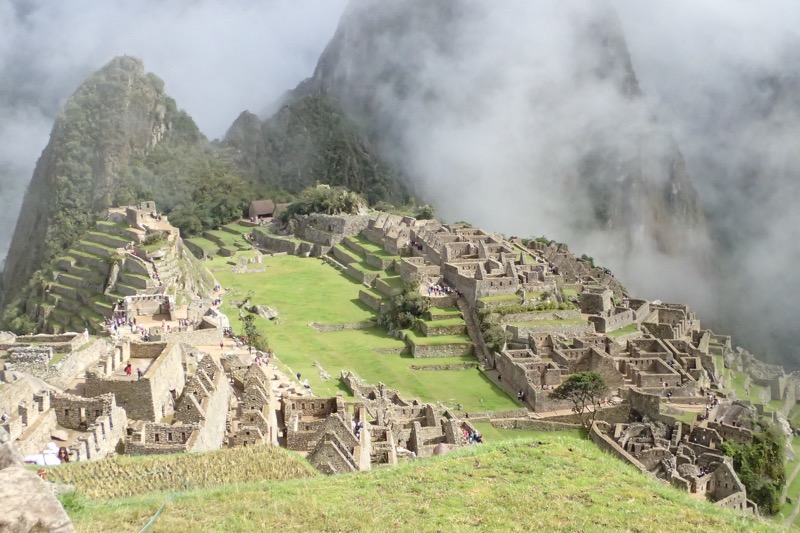 It felt like we had been through a lot to get to this point…
It felt like we had been through a lot to get to this point… 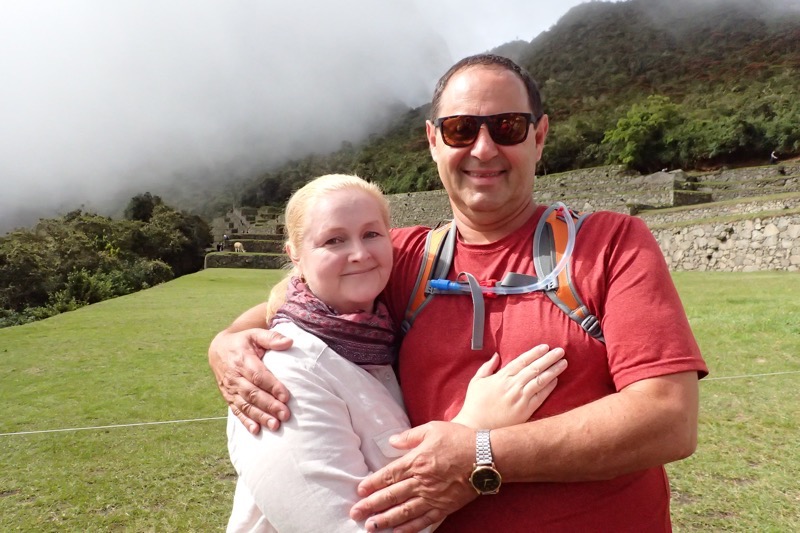 The architecture of the town is adapted to the mountains by maximising the famous terrace system. The wide parallel terraces have been created around the central east-west open square for building and for agricultural purposes. The buildings are built out of white granite and designed to utilize this terrace spaces, and their agricultural practices were also designed around the restrictions the terraces provided. Each terrace has a metre of good earth on top, under which is a metre of riverbed sand (yes, they brought it all up the mountain from the river which is hundreds of metres below!), and under that is a metre of gravel on top of the bedrock. This construction of the terraces allowed for excellent irrigation, drainage and filtration of the water system that flows through the mountain town.
The architecture of the town is adapted to the mountains by maximising the famous terrace system. The wide parallel terraces have been created around the central east-west open square for building and for agricultural purposes. The buildings are built out of white granite and designed to utilize this terrace spaces, and their agricultural practices were also designed around the restrictions the terraces provided. Each terrace has a metre of good earth on top, under which is a metre of riverbed sand (yes, they brought it all up the mountain from the river which is hundreds of metres below!), and under that is a metre of gravel on top of the bedrock. This construction of the terraces allowed for excellent irrigation, drainage and filtration of the water system that flows through the mountain town. 



 I know – so many photos, but I just couldn’t pick the ‘best ones’.
I know – so many photos, but I just couldn’t pick the ‘best ones’.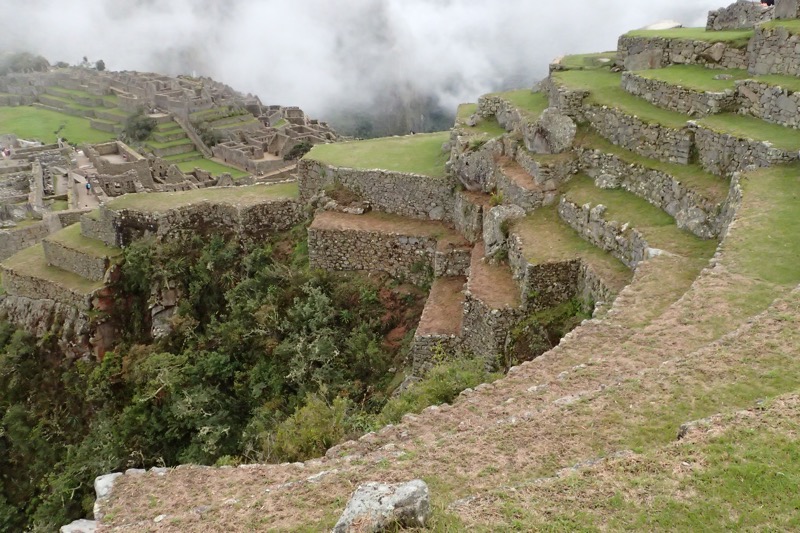


 The pathways throughout the complex were made of stone like this, it was uneven and you had to be careful, but we were very grateful that it wasn’t also wet.
The pathways throughout the complex were made of stone like this, it was uneven and you had to be careful, but we were very grateful that it wasn’t also wet.







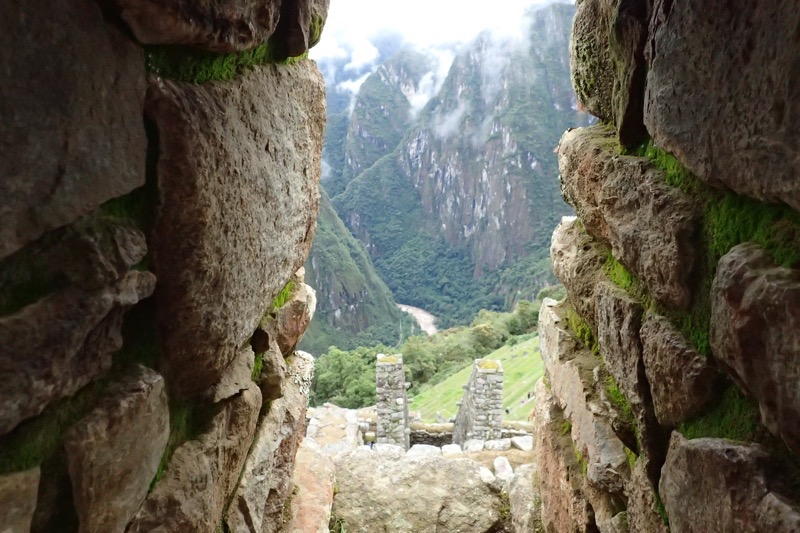

 The white granite that the 200 odd buildings of the complex are built with is all quarried right here on the top of the mountain. There are sections of the site that show that construction was still on going when the inhabitants decided to abandon the city.
The white granite that the 200 odd buildings of the complex are built with is all quarried right here on the top of the mountain. There are sections of the site that show that construction was still on going when the inhabitants decided to abandon the city.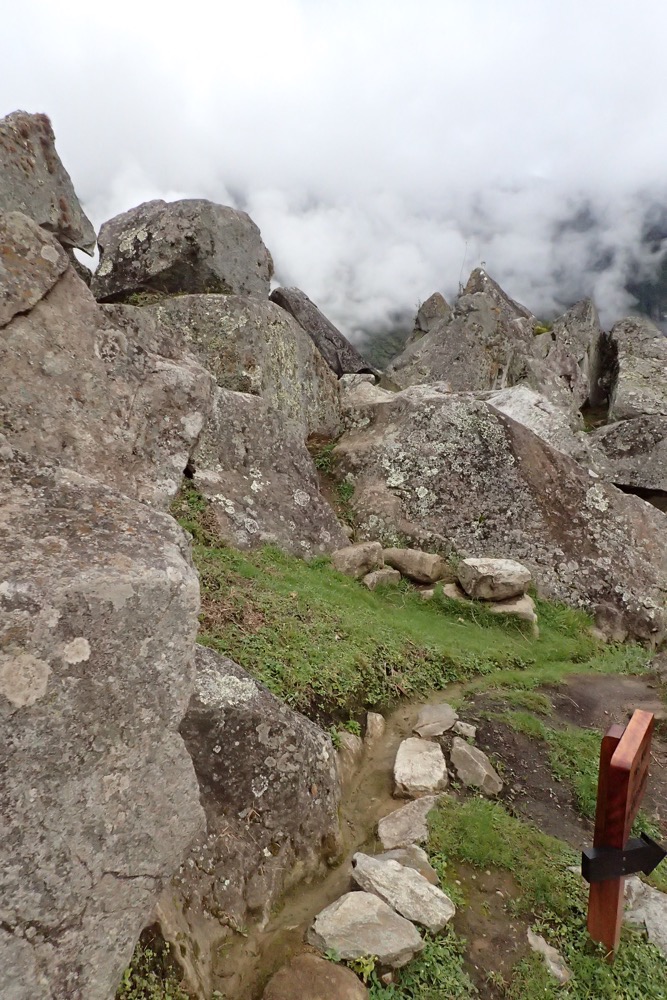 This building is a typical servant or commoner’s residence, in the Popular or Residential district of the site – it would have been a two story building, with a living, cooking and sleeping area downstairs, and a cool ventilated food storage area in the attic style roof.
This building is a typical servant or commoner’s residence, in the Popular or Residential district of the site – it would have been a two story building, with a living, cooking and sleeping area downstairs, and a cool ventilated food storage area in the attic style roof.
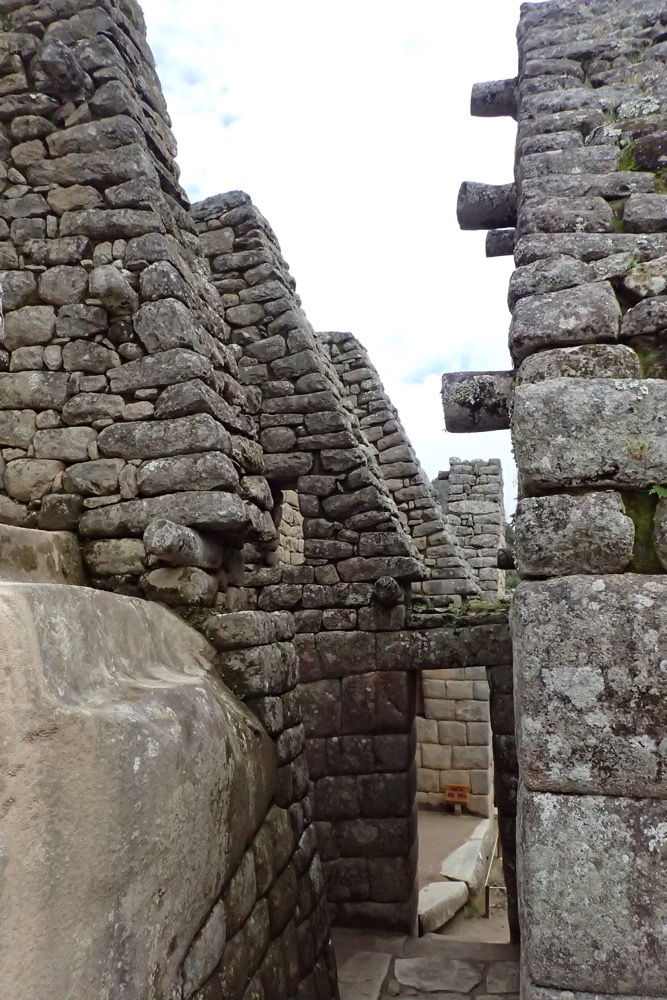

 The Temple of the Sun is part of the royalty area set out for the nobility, it features trapezoid shaped rooms and a Royal Tomb. The interior was used for sacred rites and/or sacrifices and you can see it was more finely constructed than the servants/slave/commoner buildings.
The Temple of the Sun is part of the royalty area set out for the nobility, it features trapezoid shaped rooms and a Royal Tomb. The interior was used for sacred rites and/or sacrifices and you can see it was more finely constructed than the servants/slave/commoner buildings. Inside the Royal Tomb is a three tiered rock, which is representative of the three Inka worlds, which are: the earthly world, often depicted as a puma, the underworld, associated with a snake, and the spirit world which is represented by the condor.
Inside the Royal Tomb is a three tiered rock, which is representative of the three Inka worlds, which are: the earthly world, often depicted as a puma, the underworld, associated with a snake, and the spirit world which is represented by the condor.


 The different areas of the site can be distinguished by the quality of the Inca stonework construction in each building. All the central buildings use the classical Inca architectural style of dry stone walls of regular shapes fitted tightly together. There are varying levels of workmanship evident in the stonework, varying from the rougher ‘rustic’ style which did use mortar…
The different areas of the site can be distinguished by the quality of the Inca stonework construction in each building. All the central buildings use the classical Inca architectural style of dry stone walls of regular shapes fitted tightly together. There are varying levels of workmanship evident in the stonework, varying from the rougher ‘rustic’ style which did use mortar… To a finer, ‘noble’ level of workmanship which appears on the priest and nobles residences and is dry stone…
To a finer, ‘noble’ level of workmanship which appears on the priest and nobles residences and is dry stone…
 To the near precision perfect ‘imperial’ style of stonework, that is so perfect there isn’t even gaps for a piece of paper..
To the near precision perfect ‘imperial’ style of stonework, that is so perfect there isn’t even gaps for a piece of paper..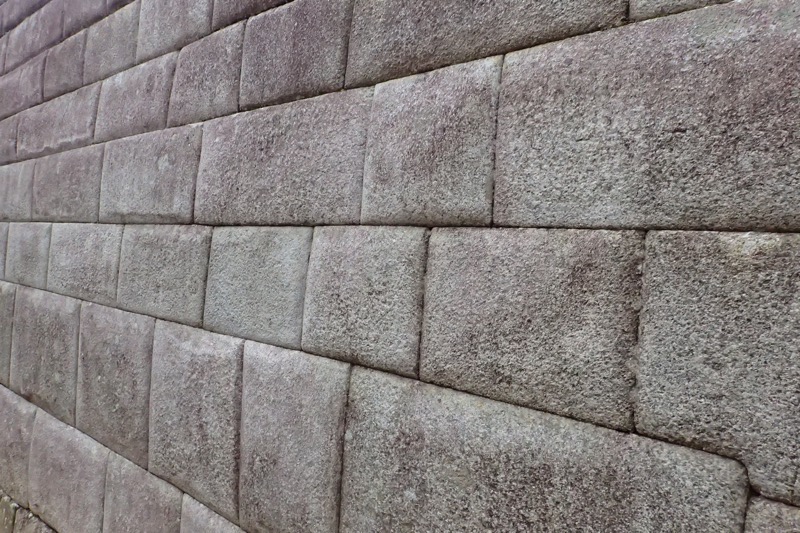

 The Main Temple is dedicated to the Earthly world, which the Inka believe is represented by the Puma. This was a sacred place of ritual and sacrifice, and it is built with the same typical Inka stonework techniques. They used heavy large stones in a trapezoidal shape that lean inwards, and this construction is very stable – however this particular building has subsided on one corner where the edge of the building was supported by earth and not bedrock, which over time, has resulted in damage.
The Main Temple is dedicated to the Earthly world, which the Inka believe is represented by the Puma. This was a sacred place of ritual and sacrifice, and it is built with the same typical Inka stonework techniques. They used heavy large stones in a trapezoidal shape that lean inwards, and this construction is very stable – however this particular building has subsided on one corner where the edge of the building was supported by earth and not bedrock, which over time, has resulted in damage.
 The Inti Watana Stone – ‘inti’ meaning ‘sun’, ‘wata’ meaning ‘to tie up or hitch’; Inti Watana literally meaning, ‘a stone or place to tie up the sun’. In English it is often called the ‘Hitching Post of the Sun’ and more often called the ‘Sun Dial Stone’; it is one of the many ritual stones on this site. It is arranged to point directly at the sun during the winter solstice, at which time it casts no shadow whatsoever. The Inka believed the stone held the sun in its proper spot on its annual movement across the sky.
The Inti Watana Stone – ‘inti’ meaning ‘sun’, ‘wata’ meaning ‘to tie up or hitch’; Inti Watana literally meaning, ‘a stone or place to tie up the sun’. In English it is often called the ‘Hitching Post of the Sun’ and more often called the ‘Sun Dial Stone’; it is one of the many ritual stones on this site. It is arranged to point directly at the sun during the winter solstice, at which time it casts no shadow whatsoever. The Inka believed the stone held the sun in its proper spot on its annual movement across the sky.
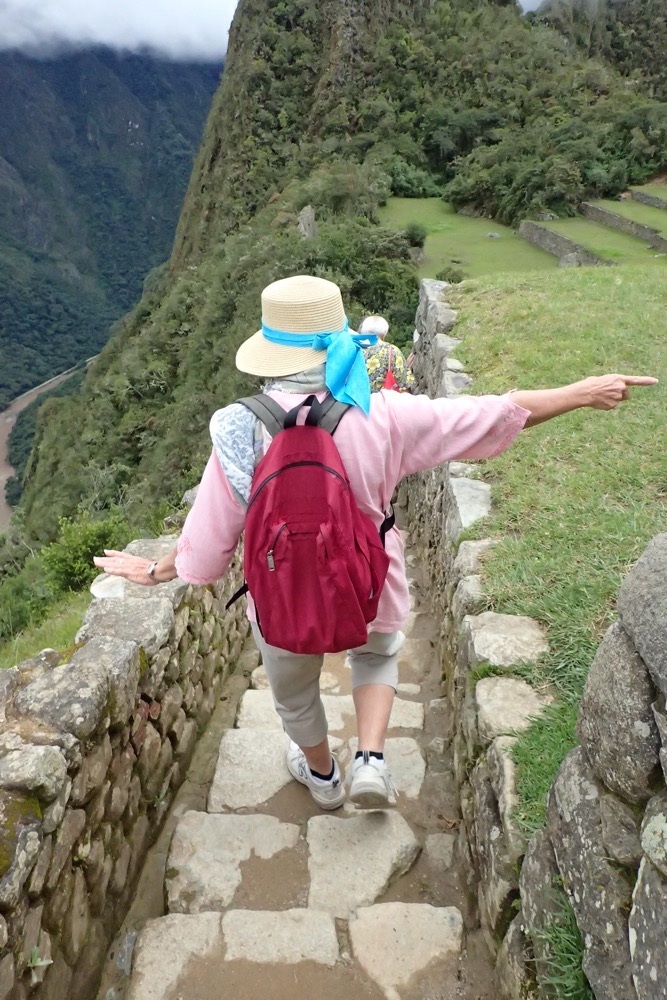 The Sacred Stone is so shaped to mirror and honour the mountain of the same shape which is directly behind it from this vantage point – unfortunately today, the mountain is hidden in the ‘cloud forest’. Offerings and small sacrifices to the mountains were often made at this stone.
The Sacred Stone is so shaped to mirror and honour the mountain of the same shape which is directly behind it from this vantage point – unfortunately today, the mountain is hidden in the ‘cloud forest’. Offerings and small sacrifices to the mountains were often made at this stone. Luis, our expert guide, Jaime, our super friendly, ultra organised travel guru, and some of our now weary, but very happy hikers.
Luis, our expert guide, Jaime, our super friendly, ultra organised travel guru, and some of our now weary, but very happy hikers. The Temple of the Condor – the large diagonal stonework represents the wings of the condor, and the stone in the ground, it’s head. It is a rather small spot in the site, and it was difficult to get a photograph that displayed the condor outline well… this temple honours the spirit world, that the Inka people aspired to ascend to.
The Temple of the Condor – the large diagonal stonework represents the wings of the condor, and the stone in the ground, it’s head. It is a rather small spot in the site, and it was difficult to get a photograph that displayed the condor outline well… this temple honours the spirit world, that the Inka people aspired to ascend to.  As we were moving around these lower terraces which held all the commoner housing and the Temple of the Condor, the clouds had started to roll back in and we had a bit of light rain occasionally… I for one, was really appreciating the beautiful, moody weather – it somehow seemed perfectly suited to this sacred site.
As we were moving around these lower terraces which held all the commoner housing and the Temple of the Condor, the clouds had started to roll back in and we had a bit of light rain occasionally… I for one, was really appreciating the beautiful, moody weather – it somehow seemed perfectly suited to this sacred site.
It was now nearly midday and we had been exploring the site for over four hours, and many of us were definitely feeling the effects of all these narrow and somewhat perilous steps and walkways, and feeling very fortunate that we were not attempting to navigate these well trod smooth cobbled paths in properly wet conditions.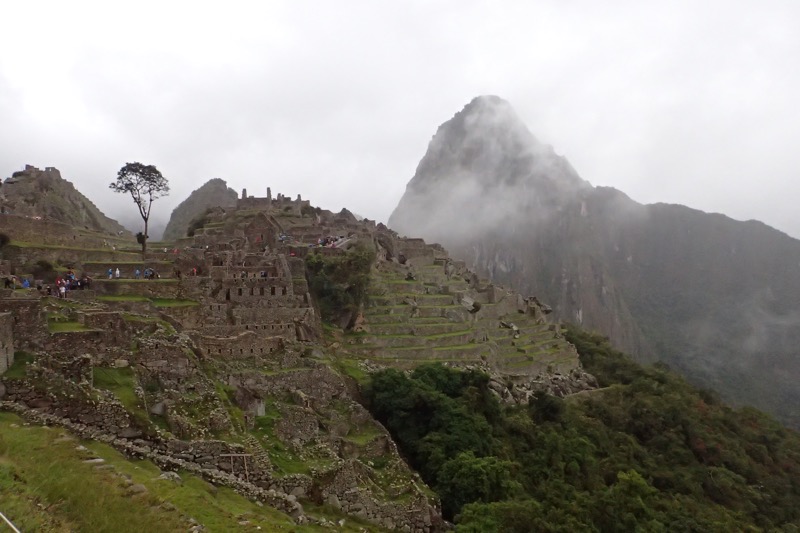 Just as we were exiting the site feeling exhilarated and energised, and for some of us a sense of achievement we didn’t think was possible – the clouds started to roll in properly and the rain went from sporadic moments of drizzle, to us pulling out all the wet weather gear. The timing could not have been more fortuitous – perhaps the Inka Sun God was smiling on us this morning.
Just as we were exiting the site feeling exhilarated and energised, and for some of us a sense of achievement we didn’t think was possible – the clouds started to roll in properly and the rain went from sporadic moments of drizzle, to us pulling out all the wet weather gear. The timing could not have been more fortuitous – perhaps the Inka Sun God was smiling on us this morning.
After a quick stop to stamp our passports with a special Machu Picchu stamp (Bother! I forgot to take a photo of it, and the ship has my passport locked away now), we then went to the Machu Picchu Sanctuary Lodge for a buffet lunch, in what must be the busiest restaurant for hundreds of kilometres. As well as having the busiest eatery in the Sacred Valley, the Sanctuary Lodge also has the distinction of being the most expensive hotel in Peru, or so I am told, costing up to USD$1000 a night to stay here! Lunch was lovely – all sorts of salads, ceviche (no peanut butter!), roast chicken, grilled trout, rice dishes, potato dishes, and of course, awesome guacamole. After walking approximately 30 flights of hard stone stairs and approximately 6km on very uneven ground (according to my tracker), it was a very welcome meal and a nice, if noisy, rest.
Around 13:00, just after we finished lunch we joined a shuttle bus queue, with other damp tourists, to get back down to Aguas Callientes. The queue was quite long, and there was no shelter from the rain, and we must have looked a bedraggled and somewhat soggy group of people, who still had huge smiles on their faces after having just enjoyed one of the most amazing life experiences ever. Wet? Sure, but I felt so glad I had been able to come to Machu Picchu and to see all this grandeur in real life, and with such a wonderful group of people and some truly amazing guides in Luis and Jaime. A little rain wasn’t going to dampen my spirits.
Just as we were boarding our buses to head back down the mountain – we happened upon friends from our ship…! The Princess shore tour people had just arrived on site at roughly 13:30, having taken the train from Ollantaytambo this morning instead of last night. My heart went out to them, they were heading into this amazing place in what was now solid and steady rain, and no doubt much of the site would be heavily under cloud by now. We didn’t have time to chat, but I do hope the weather cleared for them and they got to see something of this incredible site – I am sure we will hear how it went, and why their schedule was arranged the way it was, when we get back to the ship, but Jaime (who used to work for the ships), indicated to us that this was situation normal for ship tours… arrive late, stay short, and leave early. :/

The bus trip down was quite twice as ‘interesting’ as the bus trip up, thanks to the now slippery and muddy conditions. Aunty Mary was not at all keen on it and was trying not to look out the window, so I did my best to cheer her up, “Don’t worry about it, Mum, at least if we go over the edge we will make a good headline, ‘Twenty-Two Aussie and Kiwi Tourists Killed in Tragic Machu Picchu Bus Accident’… ‘cos there’s no way we are surviving if we go over!” Strangely, my observation didn’t seem to put her at ease… Oh well, never mind, our driver handled it like a champ. Such a winding, twisting, crossing back mountainous road, like you’ve never seen, but these drivers were unfazed and confident (ok, maybe a little *too* confident!).
We arrived back at Aguas Callientes with a few hours to spare to go check out the enormous markets that were closed when we passed through this morning. Again, we were greeted by a colourful plethora of local textiles, and having purchased a new backpack to house the goodies we had picked up in Pisaq – we felt perfectly happy trying to stuff it to the brim with more beautiful scarves and pashmina! 🙂




All shopped out, we joined The Nookies for quick happy hour pisco sour, before we had to pick up our luggage and head to our 16:00 train.
 On the wall in the restaurant where we were having a drink – I saw this most bizarre artwork… it appears to be Jesus Christ in front of Machu Picchu surrounded by disciples, at the Last Supper, but on closer inspection, it is Jesus Christ, in front of Machu Picchu, surrounded by the 14 Inca Kings! Just a fantastical blend of cultures and beliefs in this bas relief artwork – I had to share it here so I wouldn’t forget it. Completely bizarre!
On the wall in the restaurant where we were having a drink – I saw this most bizarre artwork… it appears to be Jesus Christ in front of Machu Picchu surrounded by disciples, at the Last Supper, but on closer inspection, it is Jesus Christ, in front of Machu Picchu, surrounded by the 14 Inca Kings! Just a fantastical blend of cultures and beliefs in this bas relief artwork – I had to share it here so I wouldn’t forget it. Completely bizarre!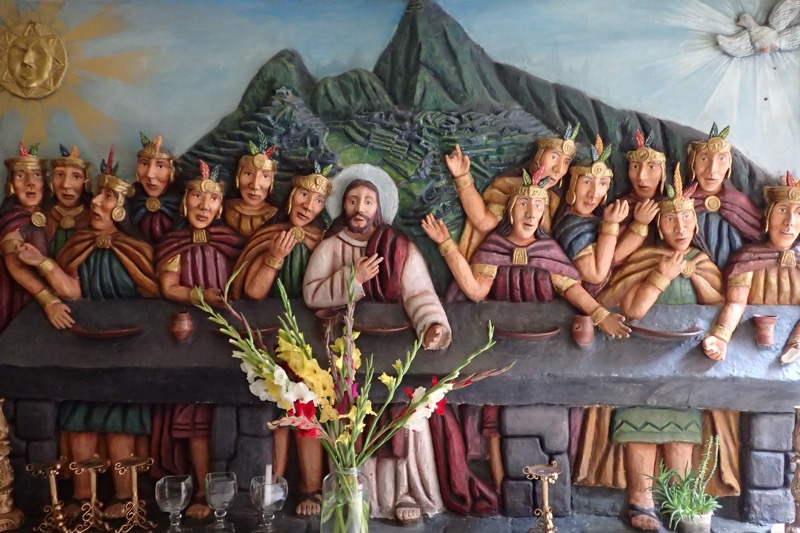
 Next we were off to the train station to head back to Ollantaytambo.
Next we were off to the train station to head back to Ollantaytambo.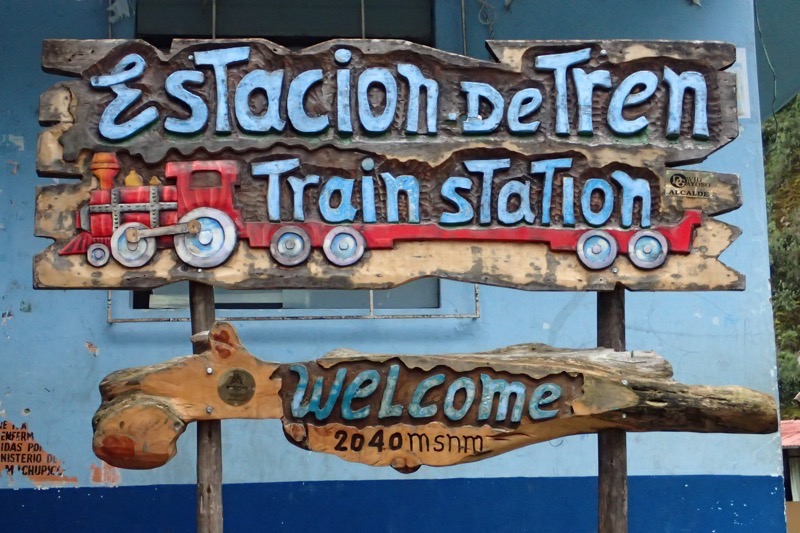 We had a ‘special carriage’ on the way back – again with the aerial dome roof to enjoy the view, which was magnificent, but this train trip also came with snacks, drinks, dancing and a fashion parade. It was a fun light hearted way to finish a magnificent day. 🙂
We had a ‘special carriage’ on the way back – again with the aerial dome roof to enjoy the view, which was magnificent, but this train trip also came with snacks, drinks, dancing and a fashion parade. It was a fun light hearted way to finish a magnificent day. 🙂 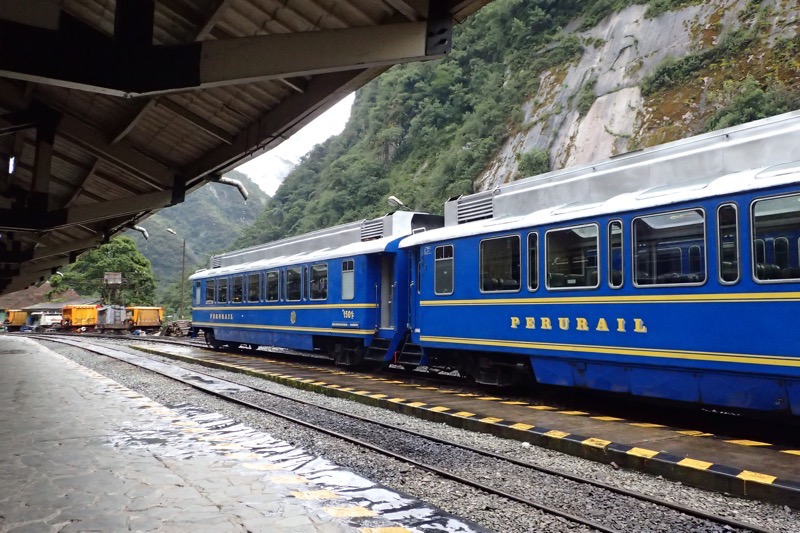
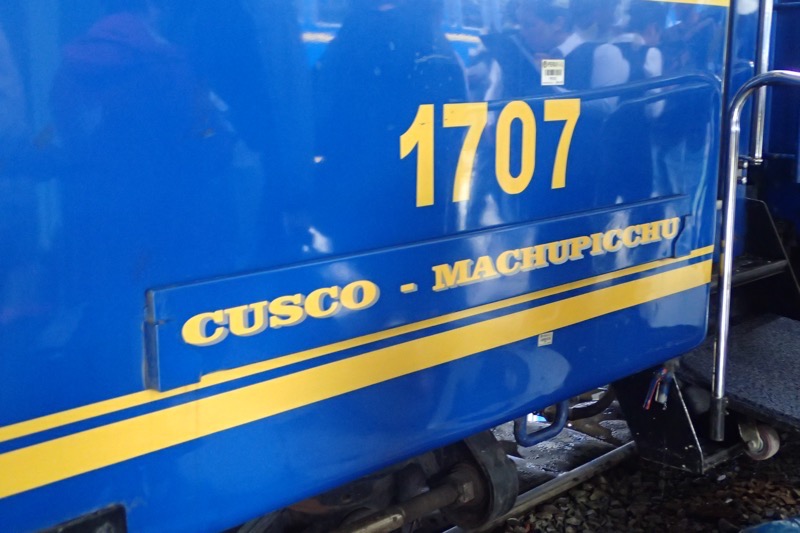 The views were amazing, and plenty of Inka ruins were visible out the windows on the ride.
The views were amazing, and plenty of Inka ruins were visible out the windows on the ride. The city of Machu Picchu sits on a saddle between two mountains, the larger Machu Picchu mountain and the smaller Huayna Picchu (pronounced Wayna Picchu) – Machu Picchu literally means ‘older mountain’, while Huayna Picchu translates to ‘younger mountain’. While we were on the site – we could see adventurous climbers trekking up Huayna Picchu to get a different view of the sacred city.
The city of Machu Picchu sits on a saddle between two mountains, the larger Machu Picchu mountain and the smaller Huayna Picchu (pronounced Wayna Picchu) – Machu Picchu literally means ‘older mountain’, while Huayna Picchu translates to ‘younger mountain’. While we were on the site – we could see adventurous climbers trekking up Huayna Picchu to get a different view of the sacred city.

On the train heading back to Ollantaytambo, I was sitting with a young man, named Han Bing who lived in Hong Kong, but hailed from Beijing, who happened to have been one of the lucky climbers on Huayna Picchu this morning. They allow only 400 people a day to climb Huayna Picchu mountain, and Bing was kind enough to air drop a few photographs he took from that vantage point. He said it was a wonderful experience, climbing up into the clouds, and then patiently waiting for the clouds to gently drift aside to reveal incredible views of the city…  Bing’s photos from Huayna Picchu:
Bing’s photos from Huayna Picchu:

 And when the clouds lifted entirely – the view is nothing short of spectacular! When (not if!), *when* I come back to South America, and to Machu Picchu, I would love to try and climb Huayna Picchu – even if it takes me an entire day. It is simply amazing.
And when the clouds lifted entirely – the view is nothing short of spectacular! When (not if!), *when* I come back to South America, and to Machu Picchu, I would love to try and climb Huayna Picchu – even if it takes me an entire day. It is simply amazing. 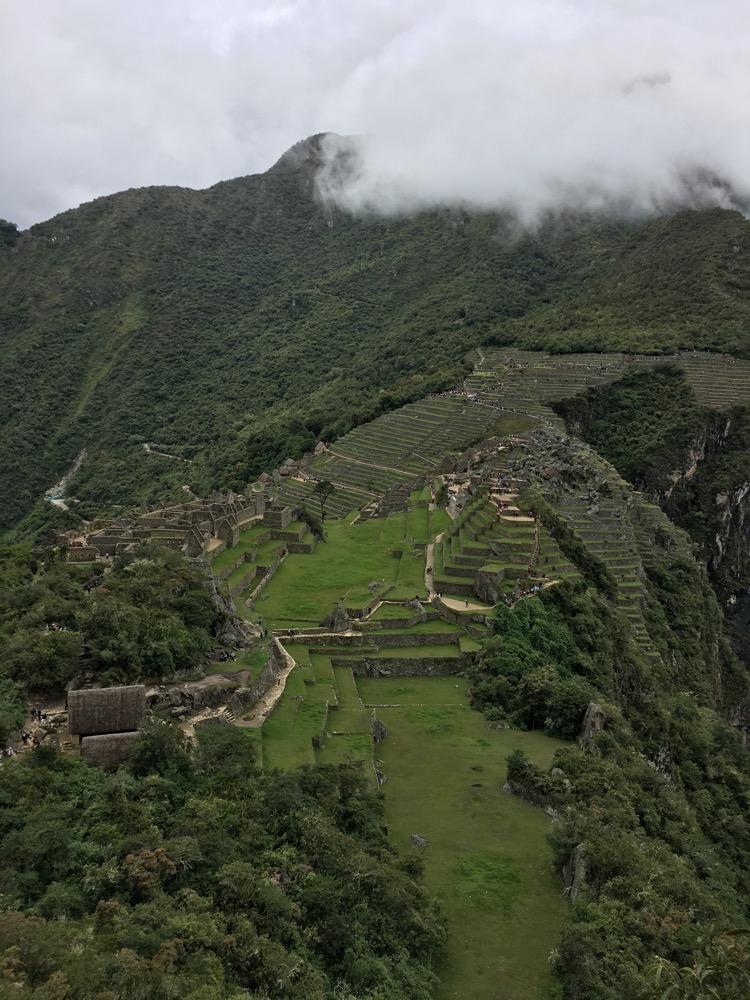
 The train entertainment – I am not sure who this guy represents or what his dance signified, but he was a whirlwind of upbeat music, clapping hands and colourful costume. This blurry mess of a picture very much captures the moment in my humble opinion. 😉
The train entertainment – I am not sure who this guy represents or what his dance signified, but he was a whirlwind of upbeat music, clapping hands and colourful costume. This blurry mess of a picture very much captures the moment in my humble opinion. 😉 
 After the dancing, there was a fashion parade as our waitstaff donned some of the lovely alpaca textiles that the region is famous for and showed us many different ways to wear a humble poncho or serape. Lovely stuff, but we had already filled our bags beyond capacity!
After the dancing, there was a fashion parade as our waitstaff donned some of the lovely alpaca textiles that the region is famous for and showed us many different ways to wear a humble poncho or serape. Lovely stuff, but we had already filled our bags beyond capacity!  Finally we arrived back to Ollantaytambo (and yes, I keep writing that O-Place down in this blog in the hope it will solidify in my brain and I will remember it without having to reach for it!), and we then had a one and a half hour drive back to Cusco. While many of our group took the opportunity to have a nap on the bus – I was the crazy lady on the bus balancing an iPad on a backpack/desk, attempting to write all this down before the sequence of events ended up muddled into yesterday or tomorrows sights. So far, I think I’ve done an okay fist of it – but there’s probably plenty of room for improvement!
Finally we arrived back to Ollantaytambo (and yes, I keep writing that O-Place down in this blog in the hope it will solidify in my brain and I will remember it without having to reach for it!), and we then had a one and a half hour drive back to Cusco. While many of our group took the opportunity to have a nap on the bus – I was the crazy lady on the bus balancing an iPad on a backpack/desk, attempting to write all this down before the sequence of events ended up muddled into yesterday or tomorrows sights. So far, I think I’ve done an okay fist of it – but there’s probably plenty of room for improvement!
Cusco at night was really beautiful – the lights climbing the Cusco hills emanating from the town centre, seemed to twinkle like stars in the sky… just to the right of this photo was a pair of young lovers enjoying the view and canoodling under the star. I was tempted to include them in this photo, but something stopped me from intruding on their intimate moment. 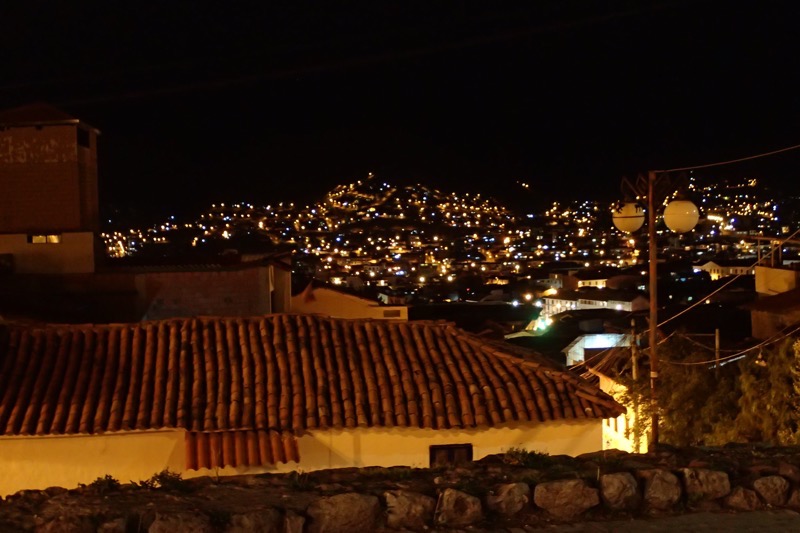 We had a bit of a wander to find our B&B… We were staying at the San Blas Boutique Hotel in the San Blas region of the city. It is a lovely part of town full of restaurants and bars, but we were all so exhausted after such a big day, that we took advantage of good quality beds, lovely big warm comforters, and (would you believe it? what a lovely touch) hot water bottles all round, and everyone went to sleep early.
We had a bit of a wander to find our B&B… We were staying at the San Blas Boutique Hotel in the San Blas region of the city. It is a lovely part of town full of restaurants and bars, but we were all so exhausted after such a big day, that we took advantage of good quality beds, lovely big warm comforters, and (would you believe it? what a lovely touch) hot water bottles all round, and everyone went to sleep early.

So this was my day in Machu Picchu. It’s been hard to put into words how I felt about this amazing place. I’ve been trying to draw comparisons of how expectations meet reality, and the only way I can describe it is to draw on other experiences.
I remember seeing photographs of the Mona Lisa many, many times, and then finally going to see the Mona Lisa at the Louvre in Paris, and being completely underwhelmed at the experience, ‘Is that it, really?’ was the general feeling. I also remember seeing many photos of places like the Colosseum in Rome or the Empire State Building in New York, but upon seeing those places in real life, I found myself thinking, ‘Wow, what an amazing testament to human endeavour’. They are impressive, they really are.
But Machu Picchu? Machu Picchu has proved to be so difficult to capture on the page, and as many of you know – I am rarely at a loss for words… I have seen photographs of this wonderful place, and I can honestly say, none of them, absolutely none of them, do it any justice whatsoever. That impressed feeling I experienced at the Colosseum or the Empire State Building, was amplified by a magnitude of 100, of 1000… it is positively indescribable (though I am trying!).
There is something so unique about this place, it has an energy, a peacefulness, a sense of true awe comes over you, a certain je ne sais quoi that I have rarely experienced anywhere else in the world. I will never forget this day or this place, it has left an indelible mark on my memory and I feel truly privileged to have been able to experience it.
 Rostock is the largest city in the northern German state of Mecklenburg-Vorpommern, located on the Warnow River. It is a beautiful university town, with the University of Rostock at its centre having been founded in the early 1400s.
Rostock is the largest city in the northern German state of Mecklenburg-Vorpommern, located on the Warnow River. It is a beautiful university town, with the University of Rostock at its centre having been founded in the early 1400s. Right next to this centre part of town is the St Marien Church. With buildings across narrow streets right beside this church on every side, it is very difficult to stand back far enough to take a photo of the outside of the building – but it is a stunning and very significant church having been built in 1230 and it contains a unique medieval astronomical clock.
Right next to this centre part of town is the St Marien Church. With buildings across narrow streets right beside this church on every side, it is very difficult to stand back far enough to take a photo of the outside of the building – but it is a stunning and very significant church having been built in 1230 and it contains a unique medieval astronomical clock. Stained glass in the southern portal windows depicting “Christ as the Judge of the World”. Tirolean stained glass painting. c.1904.
Stained glass in the southern portal windows depicting “Christ as the Judge of the World”. Tirolean stained glass painting. c.1904.  Wing of the Our Lady Altar, the painting depicting scenes from the passion of Christ. (c1430-1440AD).
Wing of the Our Lady Altar, the painting depicting scenes from the passion of Christ. (c1430-1440AD).
 The Prince’s Gallery and pipe organ were added in 1749-1751 for Duke Christian Ludwig II who reigned at this period. The two-storey organ was Rostock local, Paul Schmidt, however from the outset, the instrument was deemed wheezy and it needed considerable restoration work as early as 1791. The present organ dates from 1938 and was made in Frankfurt. It is a 4-manual siding chest organ with electro-pneumatic action and 83 stops with 4 free combinations (which no doubt means something to someone, but very little to me). It certainly is quite an impressive work of art.
The Prince’s Gallery and pipe organ were added in 1749-1751 for Duke Christian Ludwig II who reigned at this period. The two-storey organ was Rostock local, Paul Schmidt, however from the outset, the instrument was deemed wheezy and it needed considerable restoration work as early as 1791. The present organ dates from 1938 and was made in Frankfurt. It is a 4-manual siding chest organ with electro-pneumatic action and 83 stops with 4 free combinations (which no doubt means something to someone, but very little to me). It certainly is quite an impressive work of art.
 Both the organ, the Prince’s Gallery, and the pulpit which was added around the same time have been executed in a soft olive green with gilded accents to maintain a singular colour scheme with the main altar.
Both the organ, the Prince’s Gallery, and the pulpit which was added around the same time have been executed in a soft olive green with gilded accents to maintain a singular colour scheme with the main altar. The main altar was created by cabinet maker Kahlert and painters Hohenschildt, Marggraf and Bromann.
The main altar was created by cabinet maker Kahlert and painters Hohenschildt, Marggraf and Bromann. Behind the main altar is the most extraordinary astronomical clock that was made in 1472, attributed to master clockmaker Hans Duringer. Before this, Duringer made the Danzig Clock at St Mary’s in Danzig, which together with the Rostock Clock makes the ‘Baltic Clock Family’. This clock in Rostock is the only one that still has its medieval clockworks, which are still in working order. From 1641-1643, it was renovated and extended, figures were changed and a carillon was added. The latest restoration occurred between 1974 and 1977.
Behind the main altar is the most extraordinary astronomical clock that was made in 1472, attributed to master clockmaker Hans Duringer. Before this, Duringer made the Danzig Clock at St Mary’s in Danzig, which together with the Rostock Clock makes the ‘Baltic Clock Family’. This clock in Rostock is the only one that still has its medieval clockworks, which are still in working order. From 1641-1643, it was renovated and extended, figures were changed and a carillon was added. The latest restoration occurred between 1974 and 1977. The clock consists of a calendarium and a clock face, figures of the apostles stand in niches at the top, and Christ is depicted in the middle. At midday and midnight, one of the apolstlyst walks from right to left and the carillon plays at ever other hour.
The clock consists of a calendarium and a clock face, figures of the apostles stand in niches at the top, and Christ is depicted in the middle. At midday and midnight, one of the apolstlyst walks from right to left and the carillon plays at ever other hour. The field below shows the time of day, the zodiac with the appropriate month sign, the position of the sun, and the phases of the moon. The calendarium is approximately 2m in diameter and revolves 360 degrees one every year.
The field below shows the time of day, the zodiac with the appropriate month sign, the position of the sun, and the phases of the moon. The calendarium is approximately 2m in diameter and revolves 360 degrees one every year.  Carved figures supporting the calendarium.
Carved figures supporting the calendarium. In the northern portal is this spectacular triptych altar piece.
In the northern portal is this spectacular triptych altar piece.

 Fountain in the Rostock University Square.
Fountain in the Rostock University Square.
 The Kropelin Gate is a magnificent fortification gate built in 1280, one of 22 former city gates. Now the ultra modern KTC shopping center sits incongruously right beside it!
The Kropelin Gate is a magnificent fortification gate built in 1280, one of 22 former city gates. Now the ultra modern KTC shopping center sits incongruously right beside it! View from the top of the Kropelin Gate… below are part of the medieval walled fortress.
View from the top of the Kropelin Gate… below are part of the medieval walled fortress.

 Canon balls.
Canon balls.

 Kropelin Gate.
Kropelin Gate. After wandering Rostock a little more and doing some shopping, the weather started to come in. Normally when this happens, I head for a museum, and Rostock has an excellent museum – the Kulturhistorisches Museum of Rostock. Unfortunately for us, it’s a Monday and that means, (in the habitually annoying habit of museums the world over), that all the museums in the town were unhappily closed today. Instead, we decided to head back to Warnemunde to find a nice German pub to warm up and to find a couple of pints and maybe some schnitzel… as you do!
After wandering Rostock a little more and doing some shopping, the weather started to come in. Normally when this happens, I head for a museum, and Rostock has an excellent museum – the Kulturhistorisches Museum of Rostock. Unfortunately for us, it’s a Monday and that means, (in the habitually annoying habit of museums the world over), that all the museums in the town were unhappily closed today. Instead, we decided to head back to Warnemunde to find a nice German pub to warm up and to find a couple of pints and maybe some schnitzel… as you do! I honestly thought I was ordering a chicken fillet burger of some sort… the menu said: ‘hamburger chicken schnitzel) – turned out to be chicken schnitzel with potato and an egg on it! Delicious still.
I honestly thought I was ordering a chicken fillet burger of some sort… the menu said: ‘hamburger chicken schnitzel) – turned out to be chicken schnitzel with potato and an egg on it! Delicious still. The canals of Warnemunde.
The canals of Warnemunde.

 A quaint little fountain I found in a back street… I could find no information on this and not being able to read the plaque that was situated beside it, it remains a mystery. 🙂
A quaint little fountain I found in a back street… I could find no information on this and not being able to read the plaque that was situated beside it, it remains a mystery. 🙂  European lock habits strike again.
European lock habits strike again.
 As luck would have it we have arrived in the area in the middle of the summer strawberry festival – I have never seen so many strawberry based products before… strawberry soft drink, strawberry liquor, strawberry hand creams and beauty products, strawberry confectionery and strawberry homewares!
As luck would have it we have arrived in the area in the middle of the summer strawberry festival – I have never seen so many strawberry based products before… strawberry soft drink, strawberry liquor, strawberry hand creams and beauty products, strawberry confectionery and strawberry homewares!








 Oslo City Hall.
Oslo City Hall.
 There are so many things to see in Oslo, and we have relatively little time, that we have had to be selective about what we were going to see. We started off the morning heading to Vigeland park, and after getting ever so slightly lost, we discovered a strikingly designed 80 hectare park with five distinctive formal garden spaces. The park showcasing over 200 sculptures created by renowned sculptor, Gustav Vigeland between 1924 and 1943… while the park itself is often referred to ‘Vigeland Park’, the term is actually a misnomer for the world’s largest sculptural installation from a single artist within Frogner Park. The figurative sculptures depict the various stages and elements of the human life cycle, from birth to death to everything in between.
There are so many things to see in Oslo, and we have relatively little time, that we have had to be selective about what we were going to see. We started off the morning heading to Vigeland park, and after getting ever so slightly lost, we discovered a strikingly designed 80 hectare park with five distinctive formal garden spaces. The park showcasing over 200 sculptures created by renowned sculptor, Gustav Vigeland between 1924 and 1943… while the park itself is often referred to ‘Vigeland Park’, the term is actually a misnomer for the world’s largest sculptural installation from a single artist within Frogner Park. The figurative sculptures depict the various stages and elements of the human life cycle, from birth to death to everything in between. 
 The Monolith at the center of the park.
The Monolith at the center of the park.




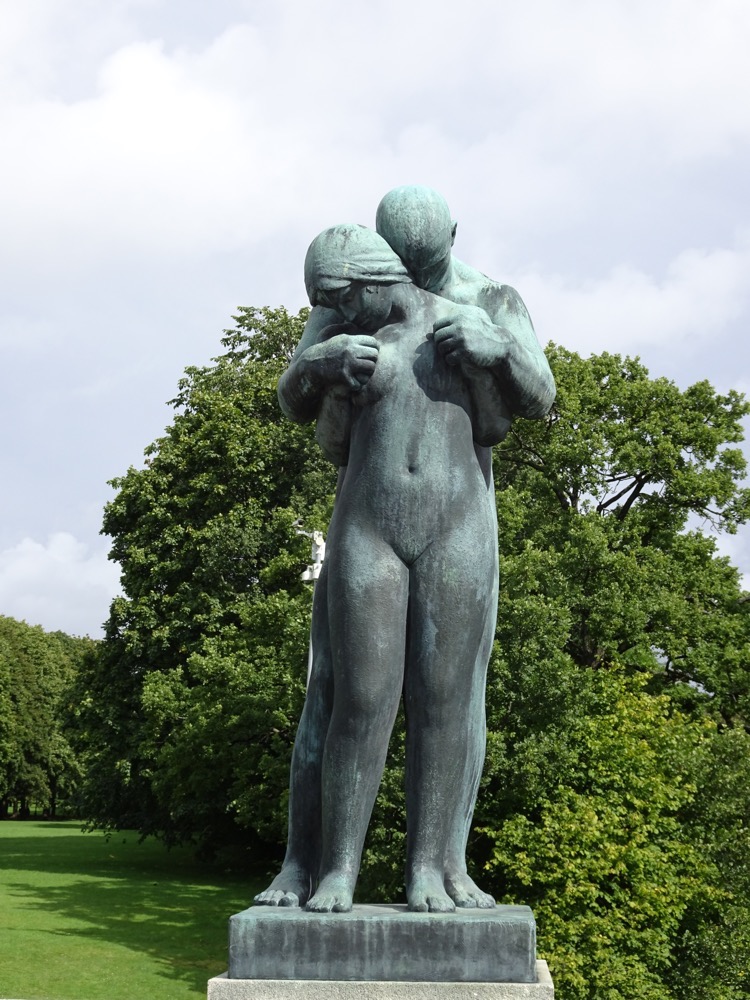

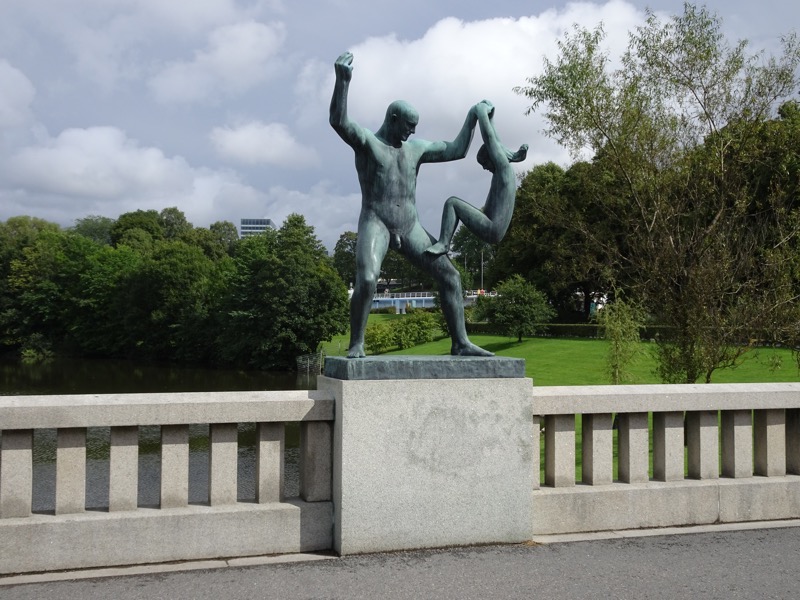
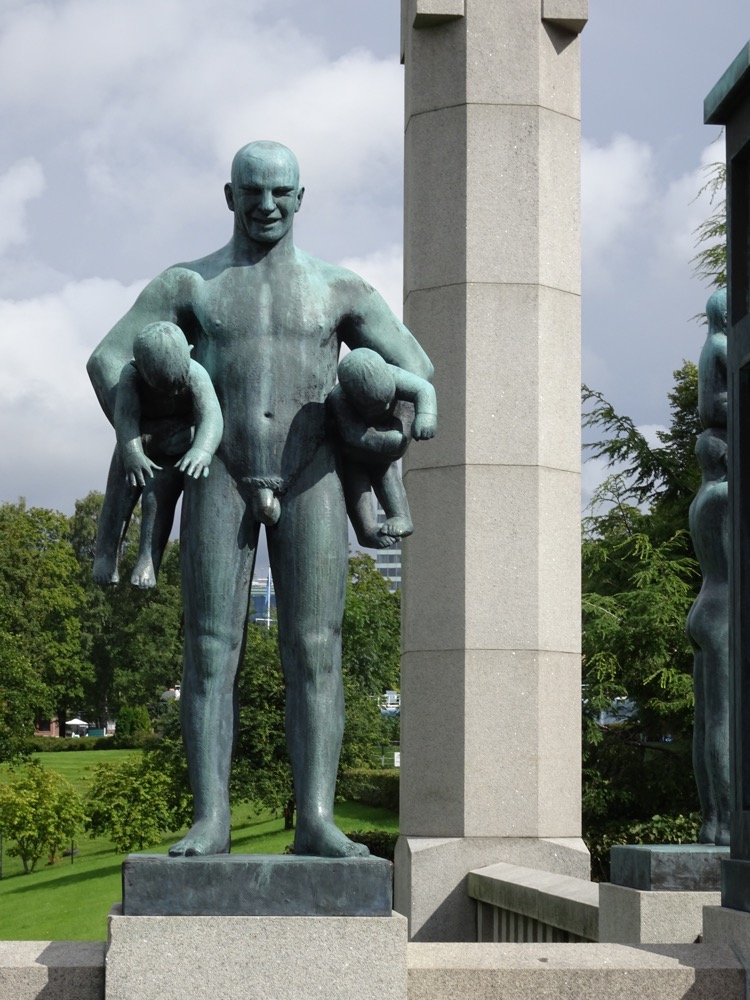
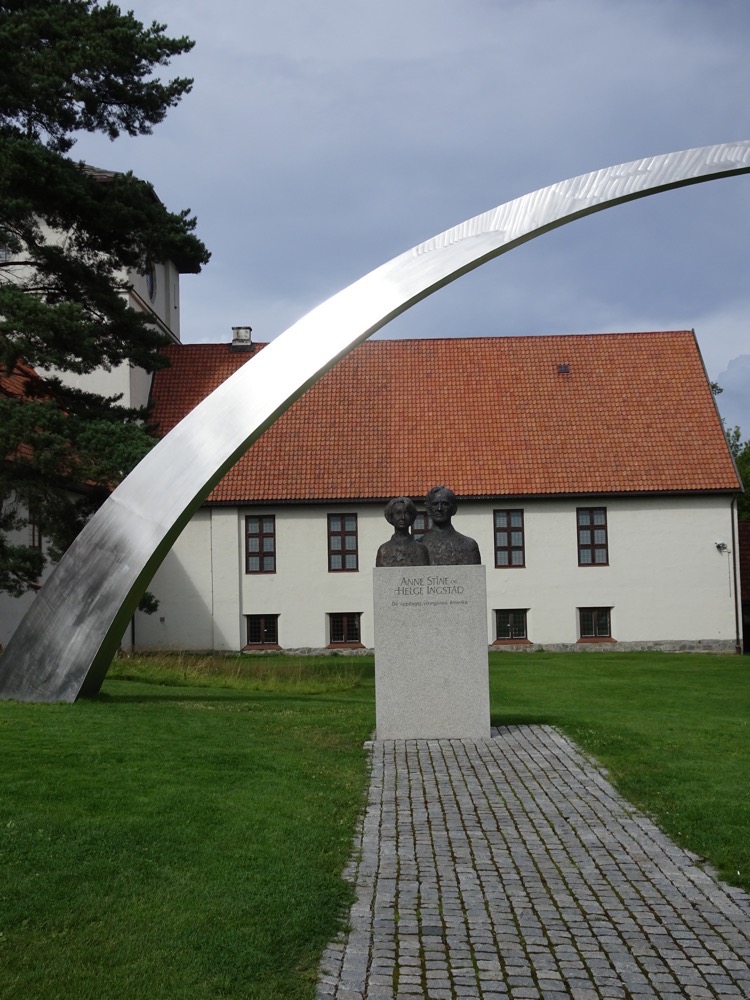 The Oseberg ship, built around 820AD, is about 21.5m long and 5m wide. There are oar holes for 15 people on each side, so with a helmsman and a lookout, there would have been a crew of about 32 or so people. Built first, but discovered last, the Oseberg ship was excavated in 1904 and took three months to complete. Two wealthy women were buried in the Oseberg ship, and they were joined by a multitude of burial girls – personal items such as clothing, shoes, combs, ship equipment, kitchen utensils, farm equipment, large decorative sleds, a huge cart, carved animal heads, five beds and two tents … along with the fifteen horses, six dogs and two cows that had been sacrificed indicated just how important these two women were. The ship itself could be both sailed and rowed and it is a particularly grand and decorative ship. The owner would have spent considerable resources in having the ship made, and was definitely an item associated with the upper classes.
The Oseberg ship, built around 820AD, is about 21.5m long and 5m wide. There are oar holes for 15 people on each side, so with a helmsman and a lookout, there would have been a crew of about 32 or so people. Built first, but discovered last, the Oseberg ship was excavated in 1904 and took three months to complete. Two wealthy women were buried in the Oseberg ship, and they were joined by a multitude of burial girls – personal items such as clothing, shoes, combs, ship equipment, kitchen utensils, farm equipment, large decorative sleds, a huge cart, carved animal heads, five beds and two tents … along with the fifteen horses, six dogs and two cows that had been sacrificed indicated just how important these two women were. The ship itself could be both sailed and rowed and it is a particularly grand and decorative ship. The owner would have spent considerable resources in having the ship made, and was definitely an item associated with the upper classes.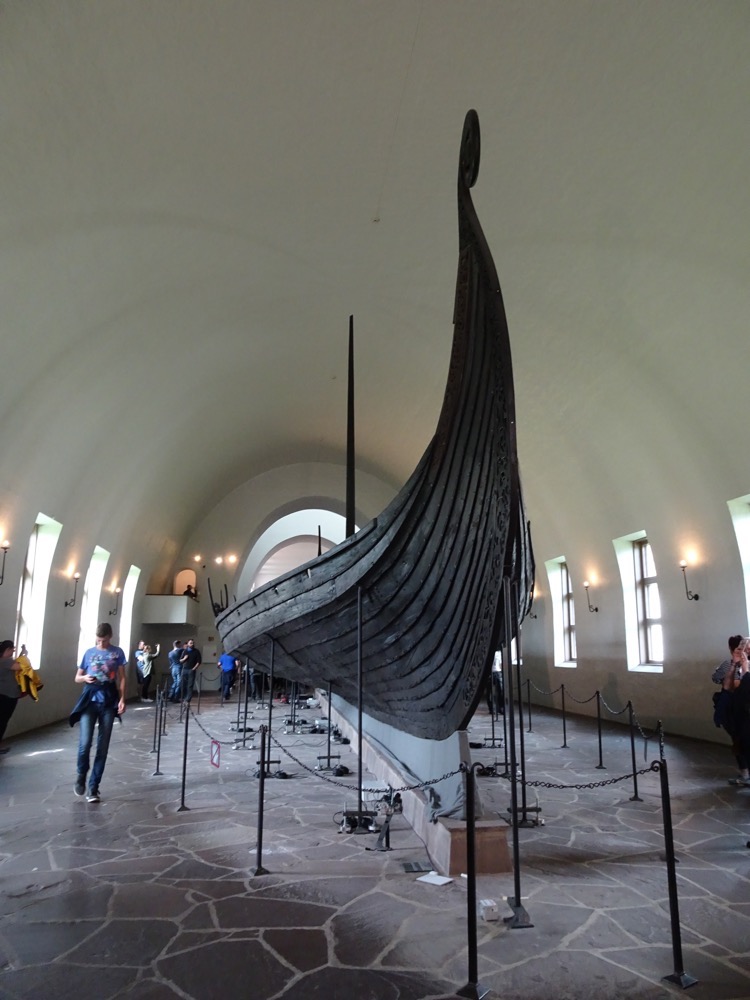








 One of several carved animal heads found in the Oseberg grave – origin and purpose for which remains unknown.
One of several carved animal heads found in the Oseberg grave – origin and purpose for which remains unknown. Oseberg chest.
Oseberg chest.
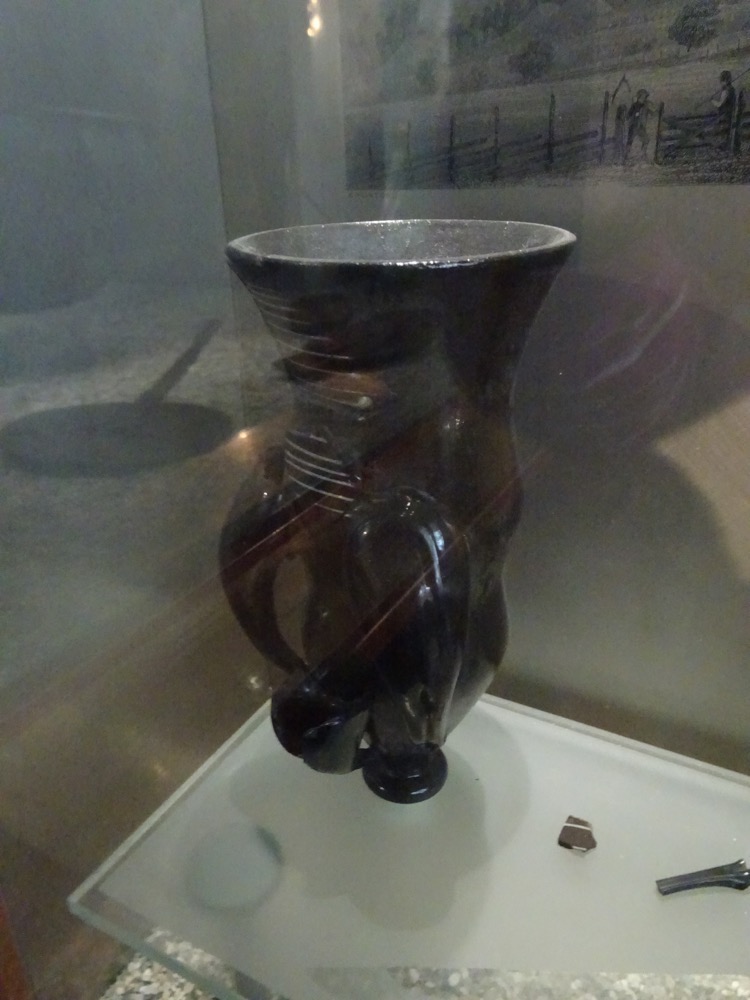
 Very odd enameled mount on a bucket handle. Bucket found in the Oseberg grave, but determined to be of Irish origin. I’m buggered if that doesn’t look like actual heraldry on something that was buried c.820AD.
Very odd enameled mount on a bucket handle. Bucket found in the Oseberg grave, but determined to be of Irish origin. I’m buggered if that doesn’t look like actual heraldry on something that was buried c.820AD.






 After the excitement of the Vikingskiphuset (we got there just at the right time while people were all busy having lunch, but it got very busy as we were leaving), we decided to swing by the open-air Norsk Folkemuseum (Norwegian Museum of Cultural History), primarily to see the only surviving wooden stave church in Oslo.
After the excitement of the Vikingskiphuset (we got there just at the right time while people were all busy having lunch, but it got very busy as we were leaving), we decided to swing by the open-air Norsk Folkemuseum (Norwegian Museum of Cultural History), primarily to see the only surviving wooden stave church in Oslo. 

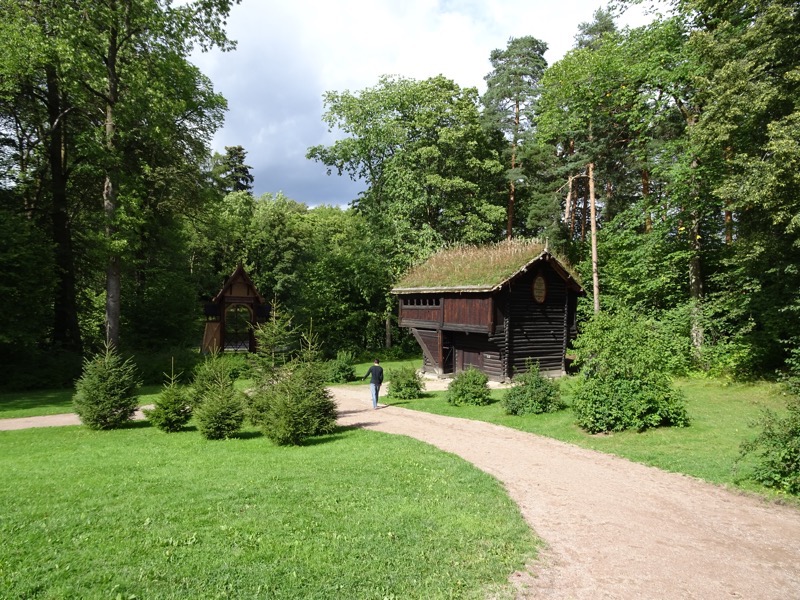 Dendrochronologically dated to the approximately 1157-1212AD, the Gol Stave Church (Gol stavkyrkje) is was originally located in the city of Gol, Hallingdal, Norway.
Dendrochronologically dated to the approximately 1157-1212AD, the Gol Stave Church (Gol stavkyrkje) is was originally located in the city of Gol, Hallingdal, Norway.
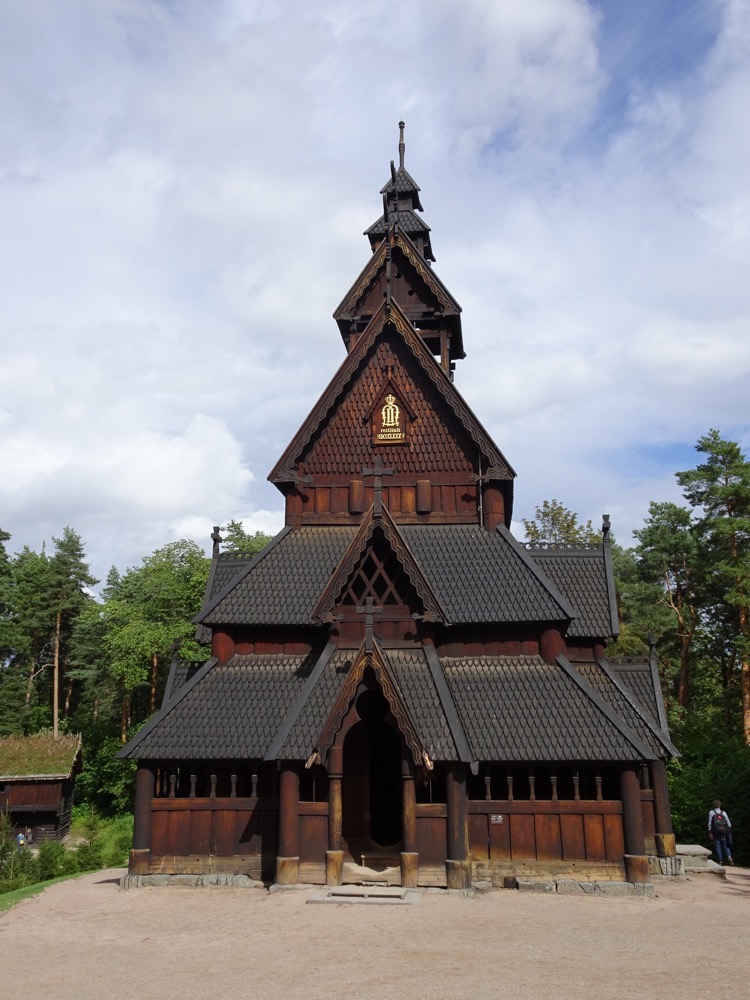





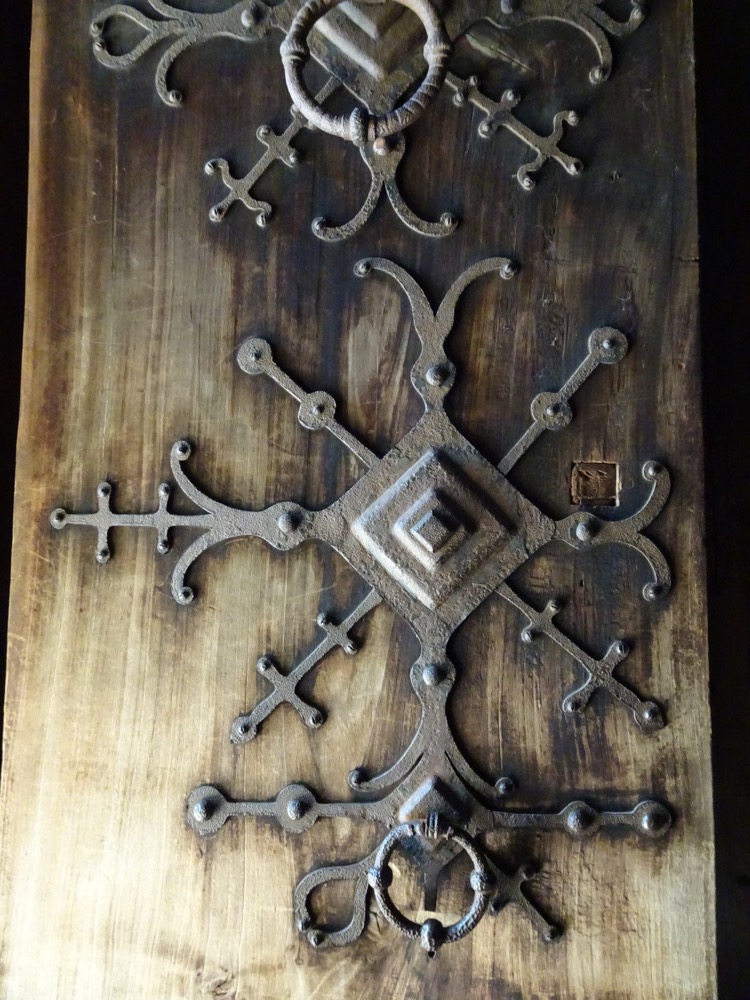 The cloisered balconies? verandahs? that surrounded the church allow you to walk the entire perimeter of the church without going outside.
The cloisered balconies? verandahs? that surrounded the church allow you to walk the entire perimeter of the church without going outside. The carved entry doors to the stave church.
The carved entry doors to the stave church.

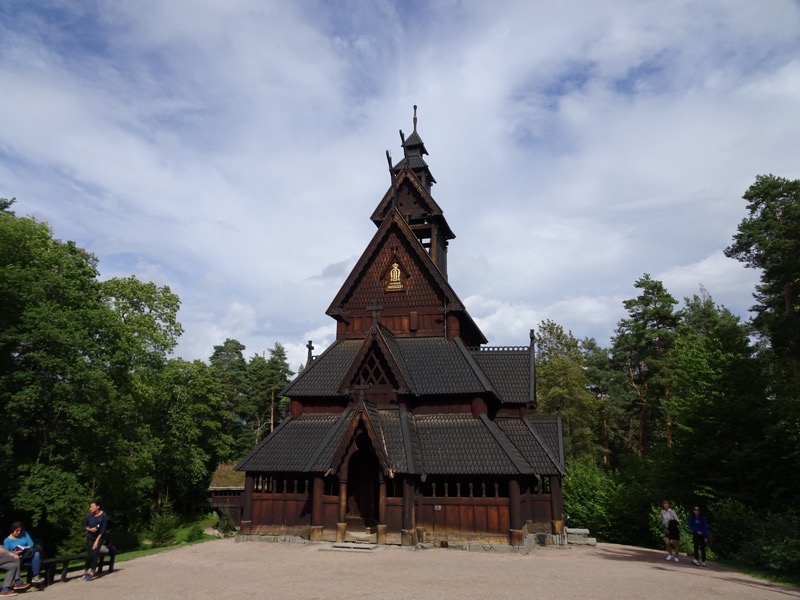





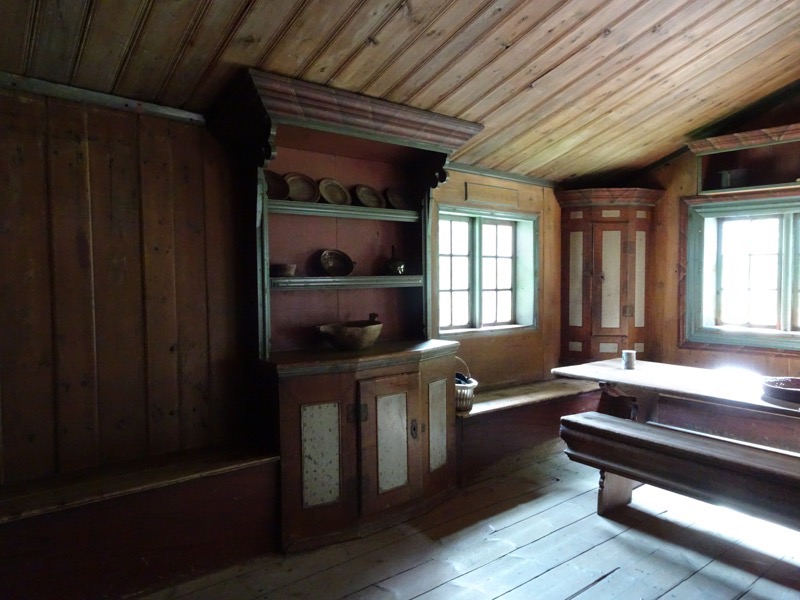





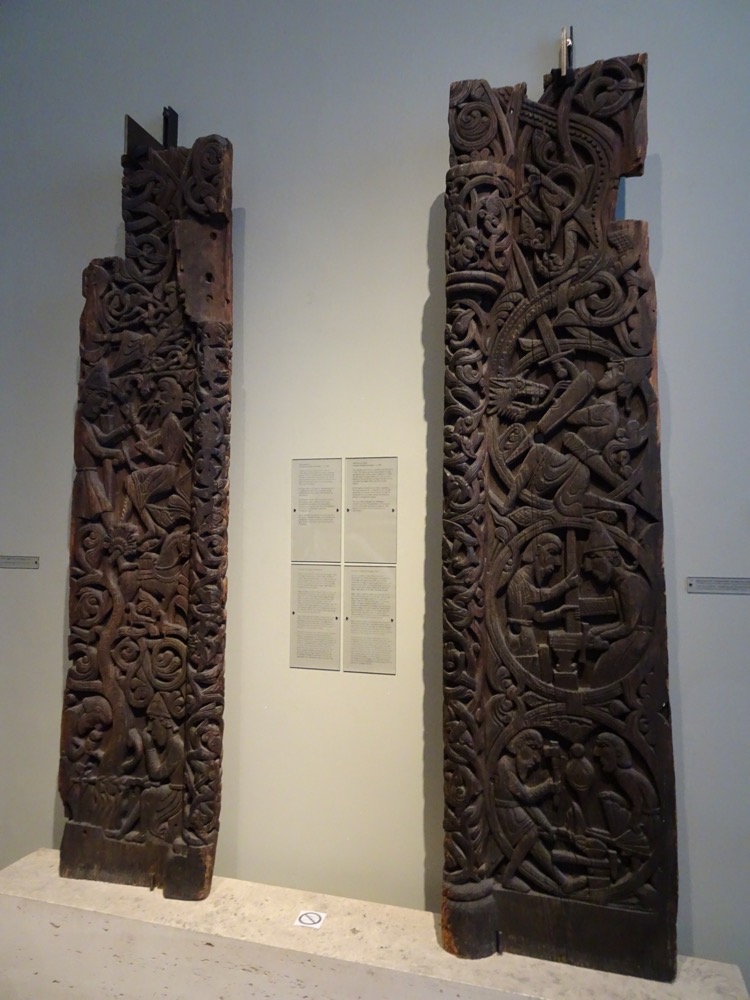 Horse collar, unknown provenance, c.1250-1300AD.
Horse collar, unknown provenance, c.1250-1300AD. Sheild, 14thC bearing Runic inscription: “Gunnar made me, Helge owns me.”
Sheild, 14thC bearing Runic inscription: “Gunnar made me, Helge owns me.”
 Drinking horn, c.1300 with secondary mounts. Horn appears to be of a native Norwegian breed of cattle.
Drinking horn, c.1300 with secondary mounts. Horn appears to be of a native Norwegian breed of cattle. Drinking horn, horn and gilt silver. 15th century, Elingard, Onsey, Ostford.
Drinking horn, horn and gilt silver. 15th century, Elingard, Onsey, Ostford.

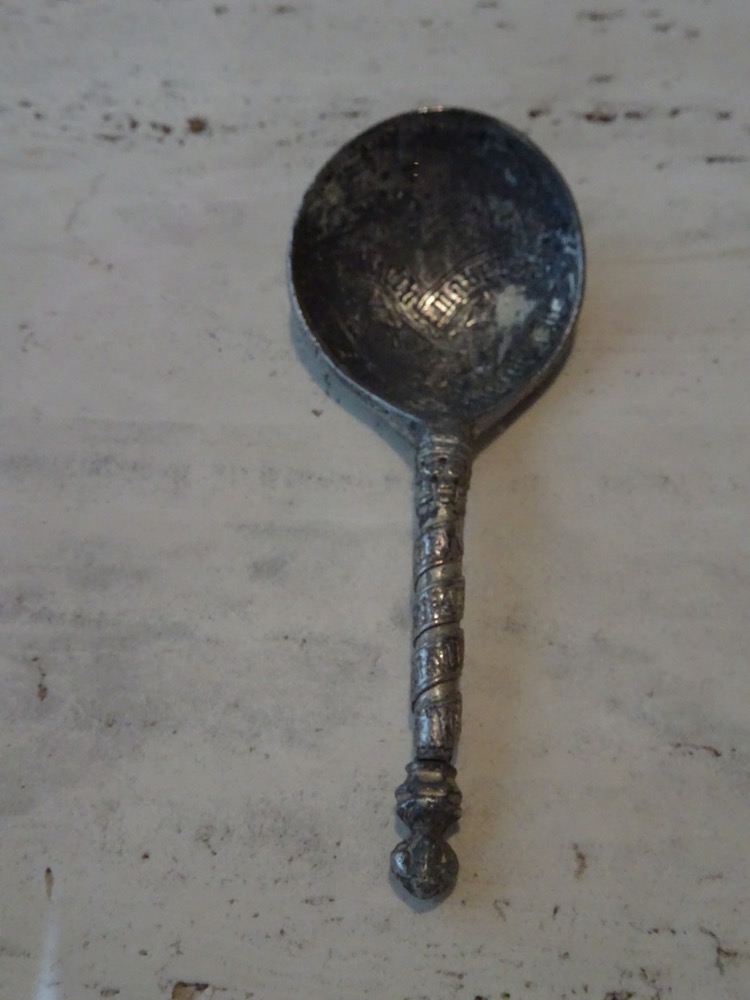 Chair, Tydol church, Osterdolen, Hedmark. c.1150-1200.
Chair, Tydol church, Osterdolen, Hedmark. c.1150-1200.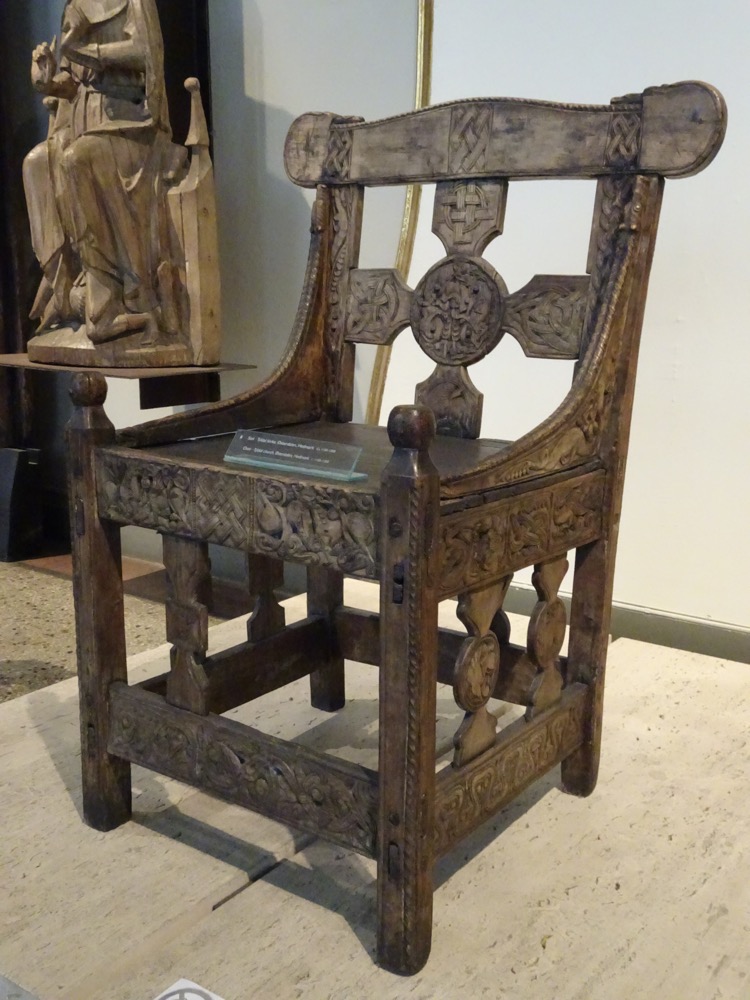 Baptismal font, Vale church, Westfold, c.1210-30.
Baptismal font, Vale church, Westfold, c.1210-30.
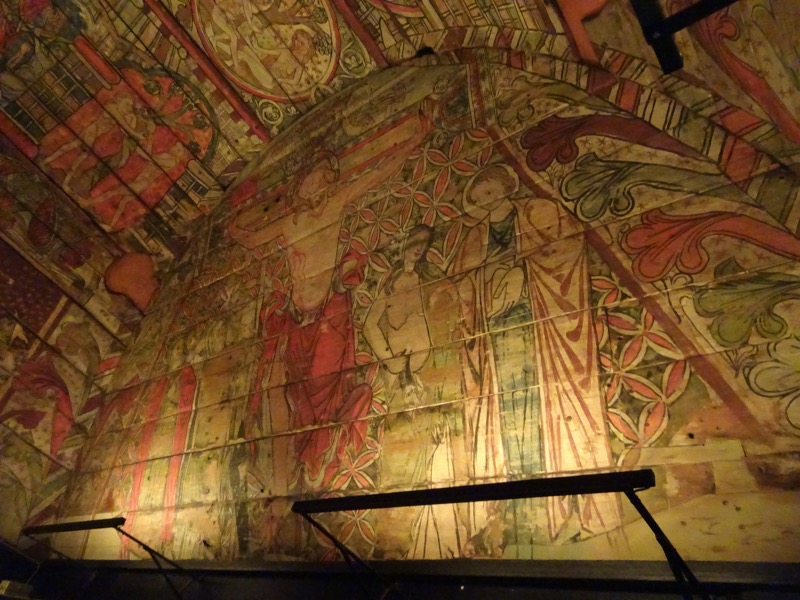
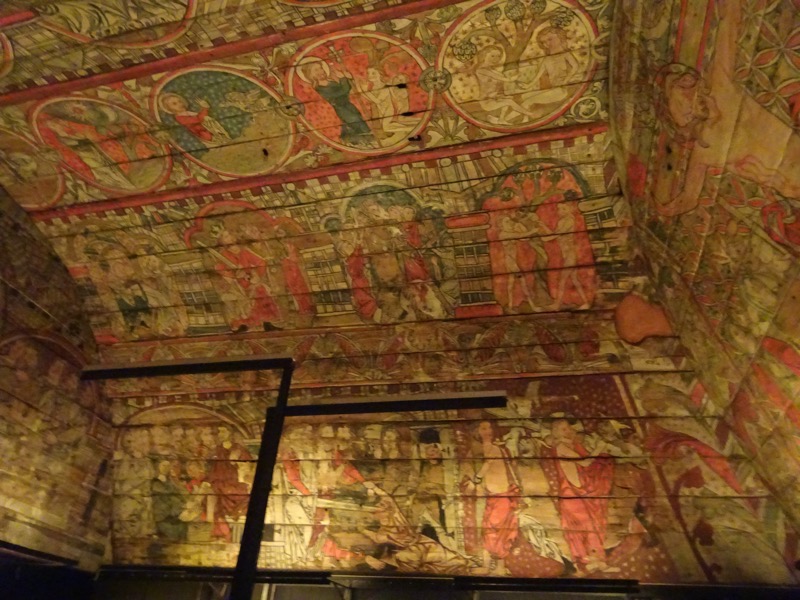


 Aquamanile (knight), Helgeland, Nordland, c.1300. Brass. Northern Germany.
Aquamanile (knight), Helgeland, Nordland, c.1300. Brass. Northern Germany.
 More lovely beads in predominantly matching colour schemes. Brooches, beads, and bracelet below – 10thC.
More lovely beads in predominantly matching colour schemes. Brooches, beads, and bracelet below – 10thC.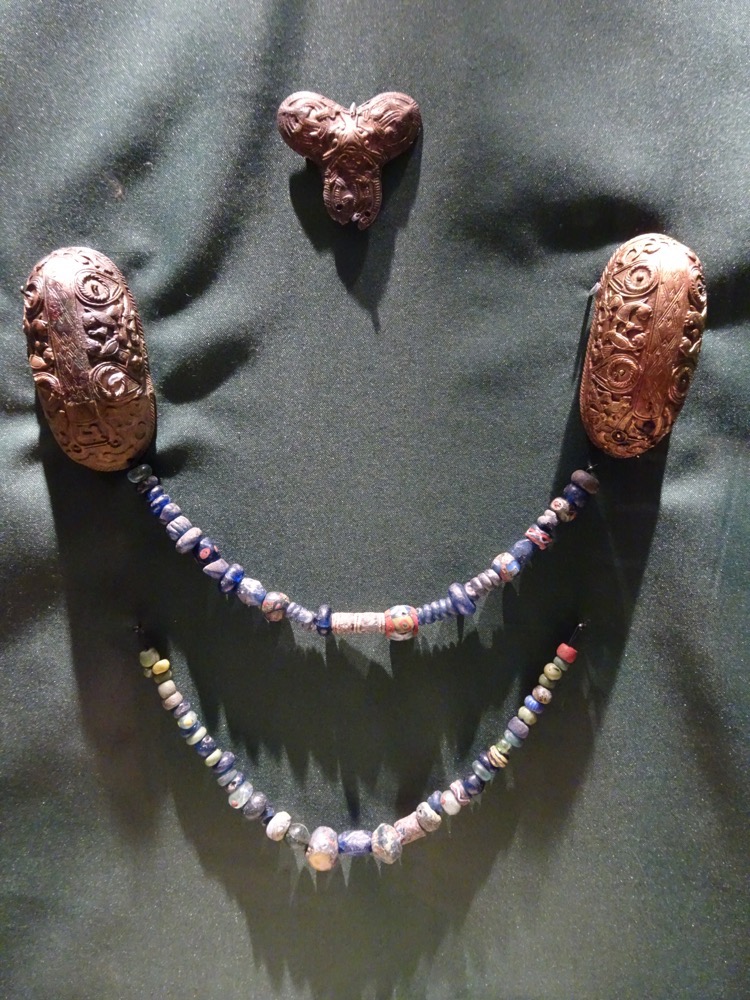
 Shaman’s drum hammer. Carved bone. 11th century, Nordset, Rendalen, Hedmark.
Shaman’s drum hammer. Carved bone. 11th century, Nordset, Rendalen, Hedmark.

 More lovely matching and symmetrical bead sets… I can’t express how pleased I am to find now three sets of beads, across Sweden and Norway, that are not a completely psychotic arrangement of chaotic colour, type and size. The order inherent in some of these bead sets is reassuring.
More lovely matching and symmetrical bead sets… I can’t express how pleased I am to find now three sets of beads, across Sweden and Norway, that are not a completely psychotic arrangement of chaotic colour, type and size. The order inherent in some of these bead sets is reassuring.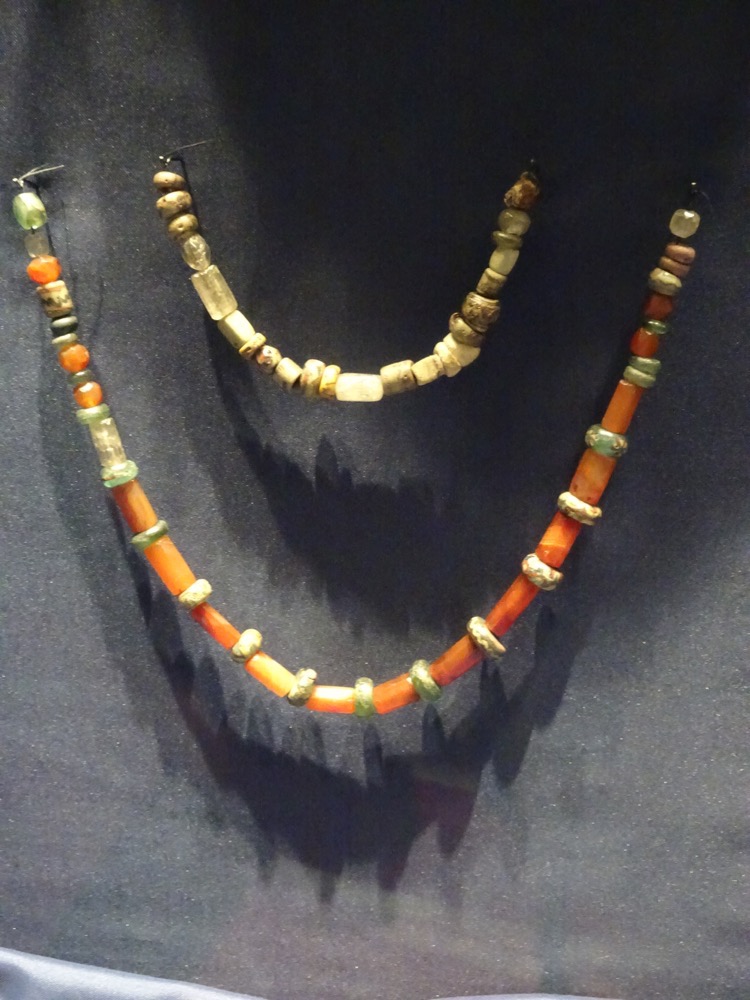 9th C tortoise broach and Verbrannte Leiche. 😀
9th C tortoise broach and Verbrannte Leiche. 😀 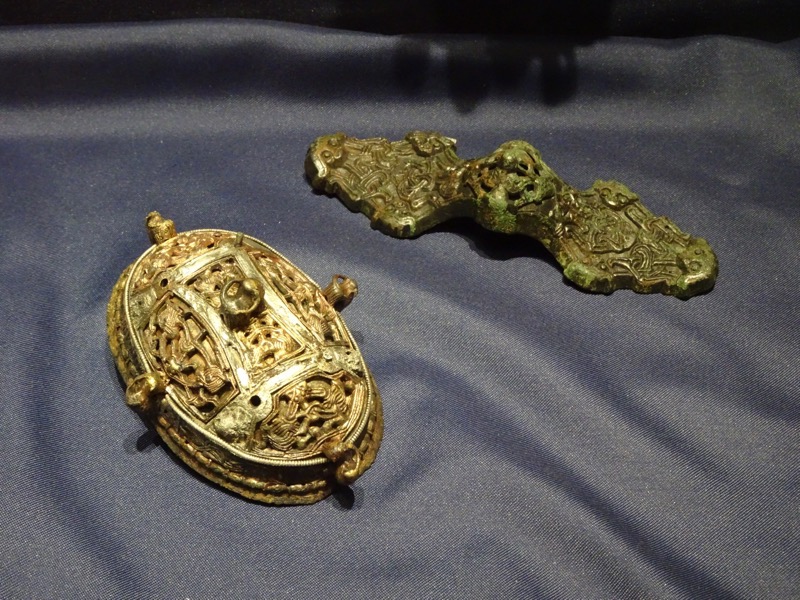



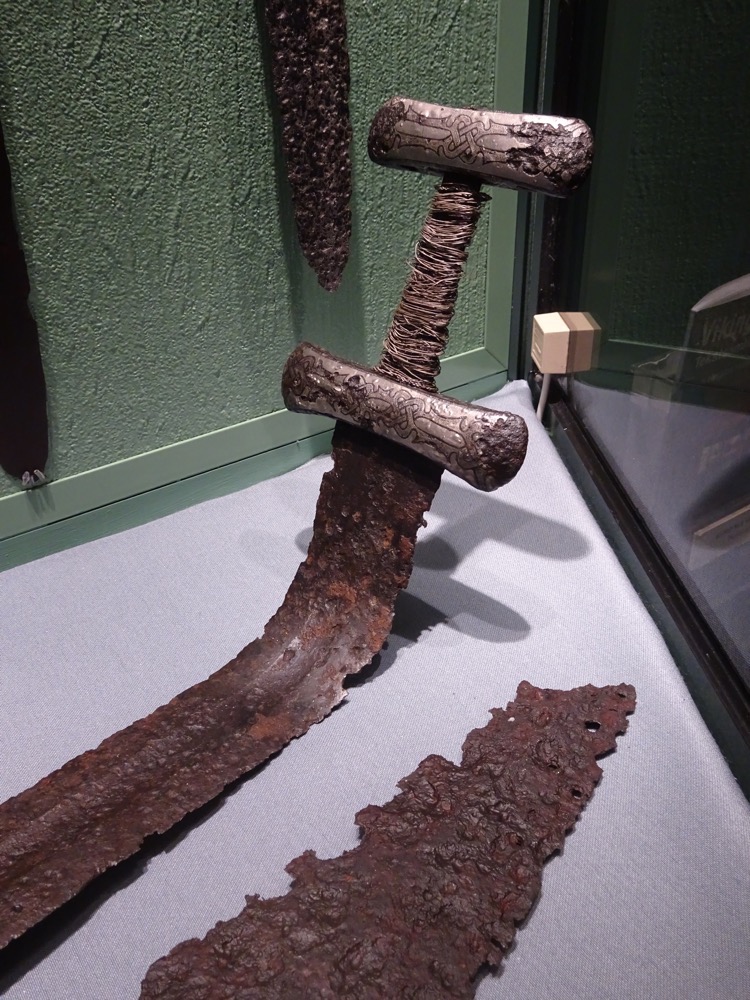
 More 9th century tortoise brooches.
More 9th century tortoise brooches.
 This amazing brooch from Hovland, Larvik, Vestfold, shows beautifully braided silver wire wound in and around the holes in the design of the brooch. I tried to photograph the underside but without success. 9th century, and appears to be very ususual.
This amazing brooch from Hovland, Larvik, Vestfold, shows beautifully braided silver wire wound in and around the holes in the design of the brooch. I tried to photograph the underside but without success. 9th century, and appears to be very ususual. Trefoil brooches. 9th-10th century.
Trefoil brooches. 9th-10th century.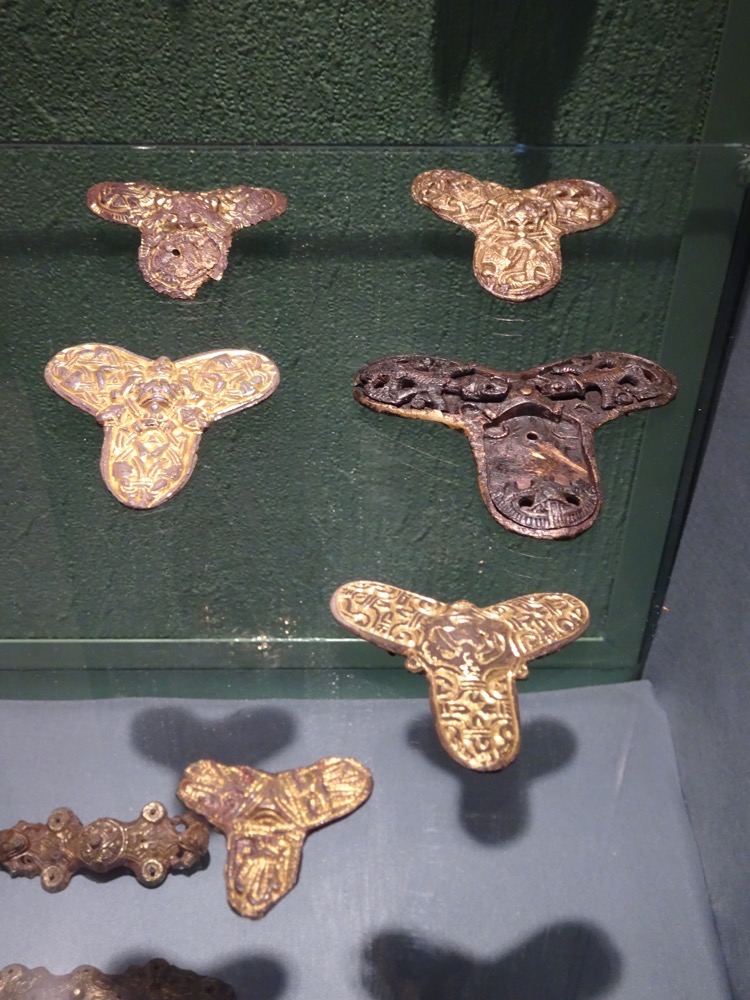



 Male jarl grave find from Funde aus Mannergrab. Gjermundbu, Ringerkike, Buskerud, 10th century:
Male jarl grave find from Funde aus Mannergrab. Gjermundbu, Ringerkike, Buskerud, 10th century: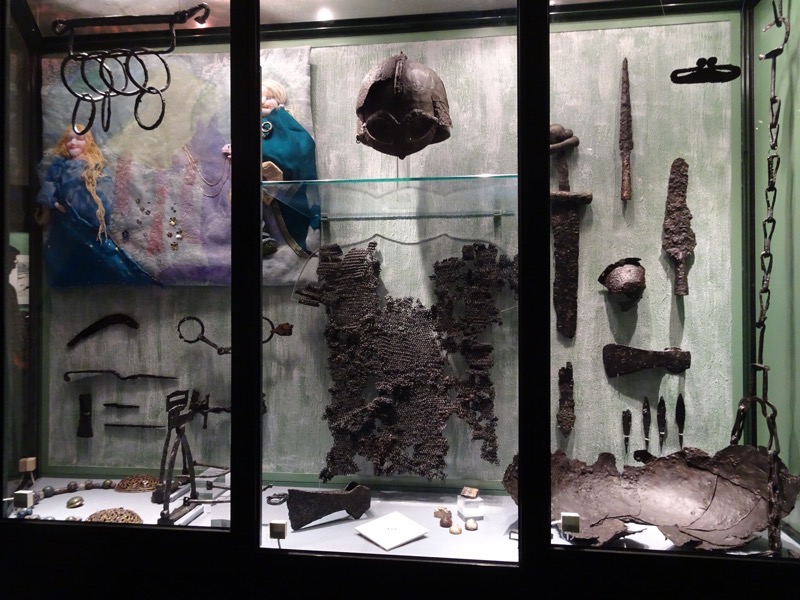 Contains: rattles, sickles, rasp, bell, knife, file, horse-bits, stirrups, spurs, helm, chain mail shirt, axe, 2 dice, 3 gaming pieces, sword, spear, fire-steel, spear, shield boss, axe, chape, cauldron, crampons, chain for cauldron.
Contains: rattles, sickles, rasp, bell, knife, file, horse-bits, stirrups, spurs, helm, chain mail shirt, axe, 2 dice, 3 gaming pieces, sword, spear, fire-steel, spear, shield boss, axe, chape, cauldron, crampons, chain for cauldron.

 Female grave find from Ryem, Vikna, Nord-Trondelag, 10th century. Brooches, and beads. Those beads were enromous… my thumb included for scale.
Female grave find from Ryem, Vikna, Nord-Trondelag, 10th century. Brooches, and beads. Those beads were enromous… my thumb included for scale. 

 Iron age tools. Used for ship building.
Iron age tools. Used for ship building. Chisel set used for timber work, ship building… possibly for rune stone carving as well.
Chisel set used for timber work, ship building… possibly for rune stone carving as well. Bowls carved using chisels.
Bowls carved using chisels. Viking sword pommels – Vaga kirke, Vaga, Oppland. 9th century.
Viking sword pommels – Vaga kirke, Vaga, Oppland. 9th century.

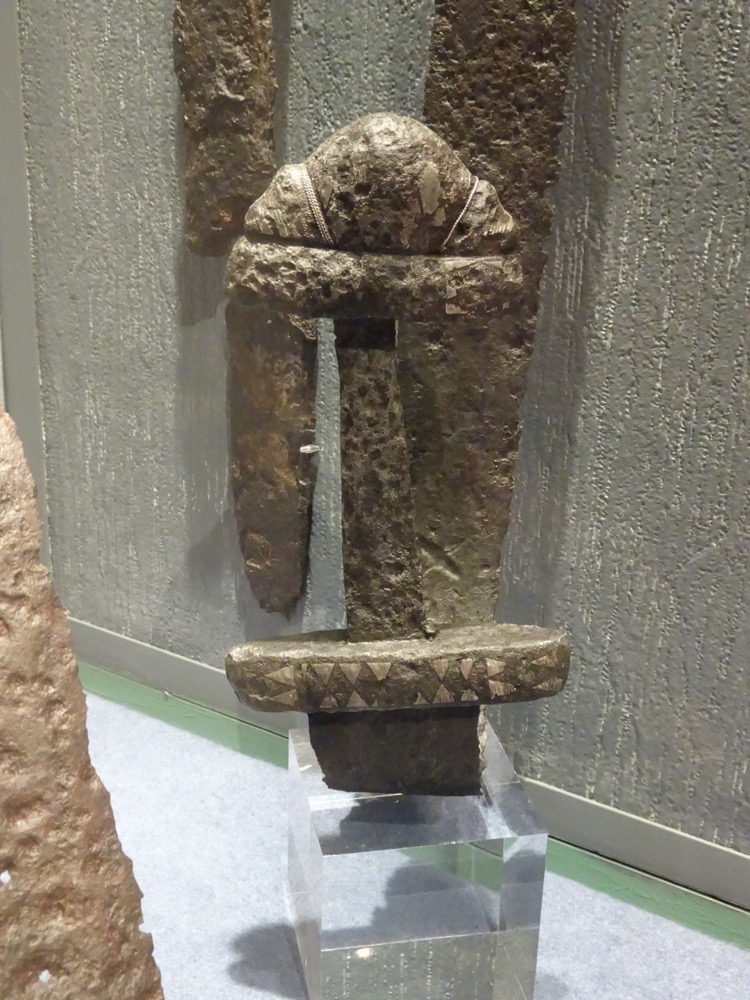

 Flattening board and flattening stones.
Flattening board and flattening stones.

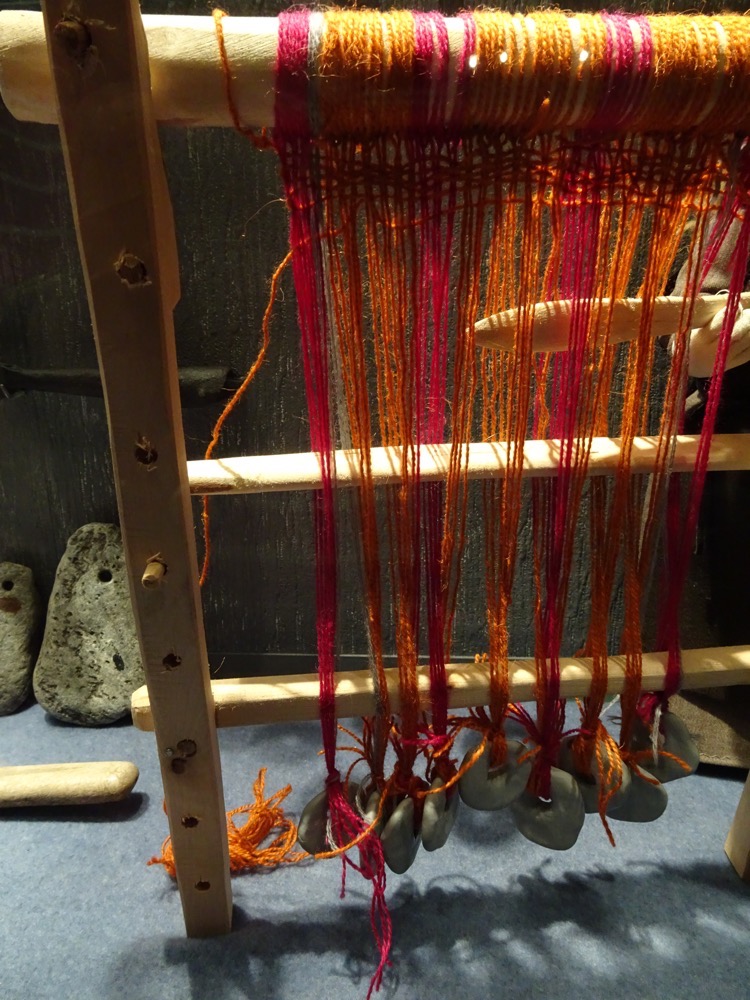 Spinning whorls.
Spinning whorls.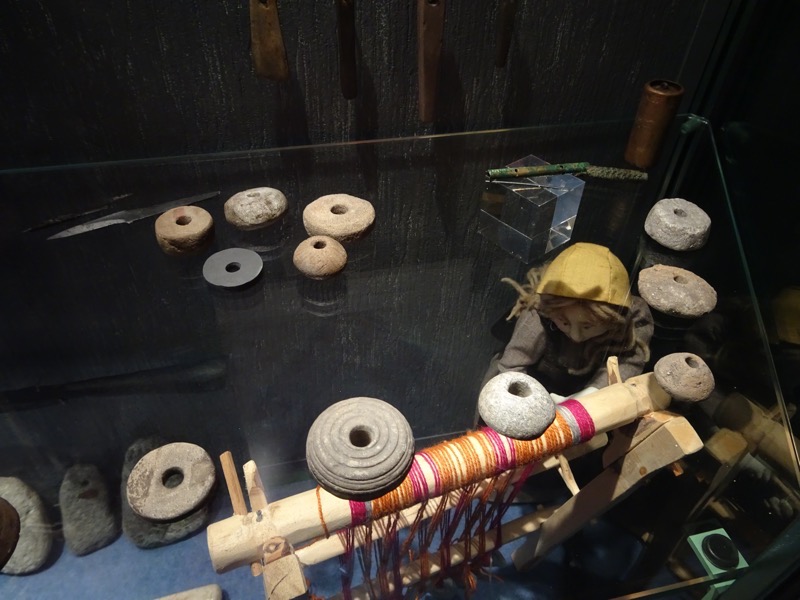 Neck band.
Neck band.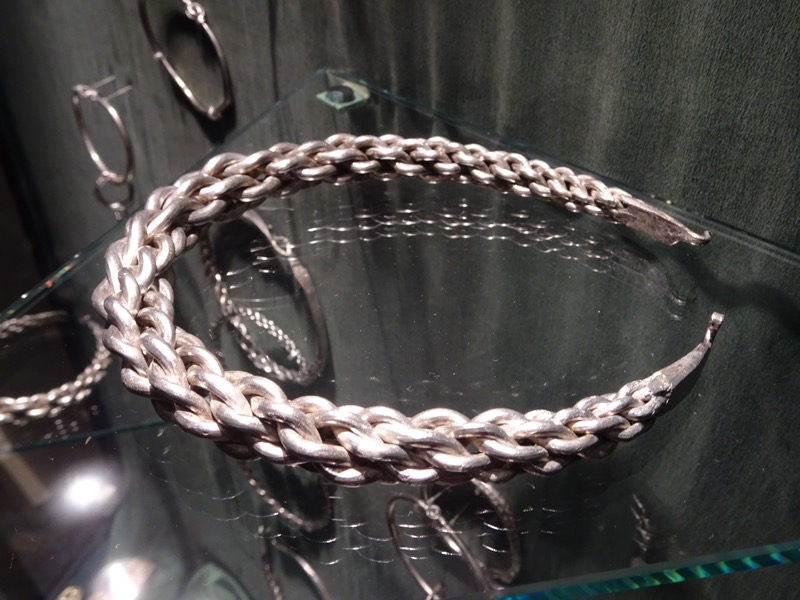 Viking shield from Oseberg grave.
Viking shield from Oseberg grave.



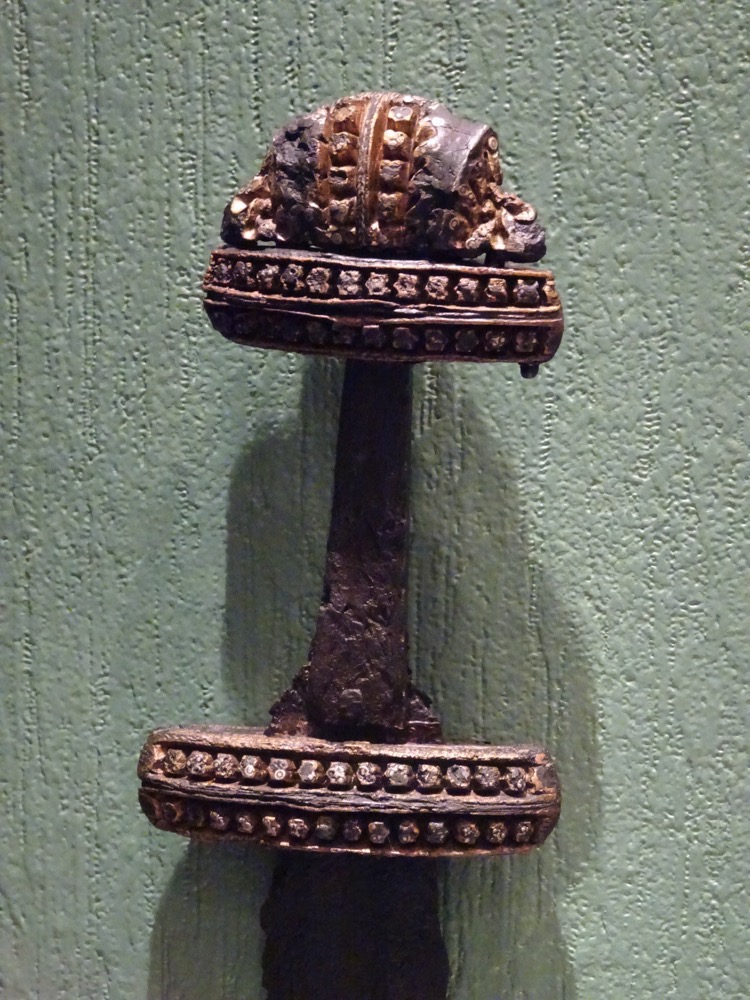








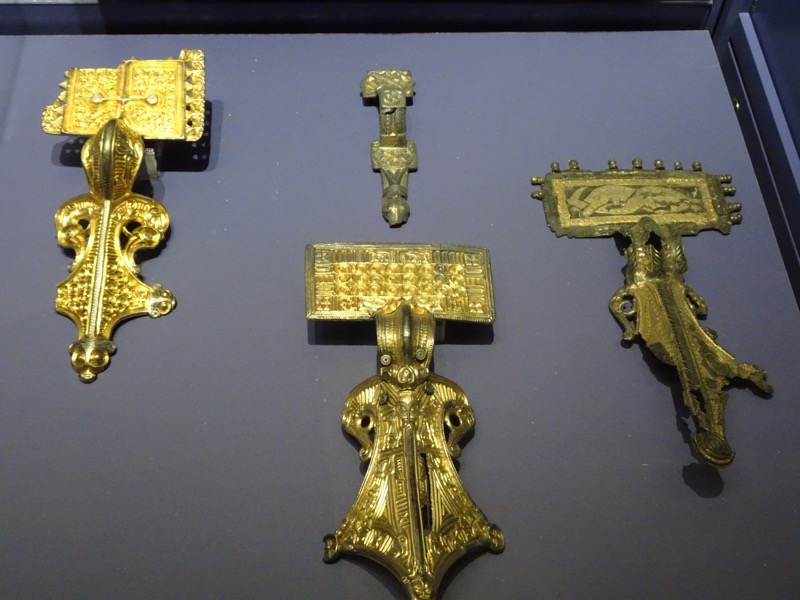
 Belt mounts.
Belt mounts. 


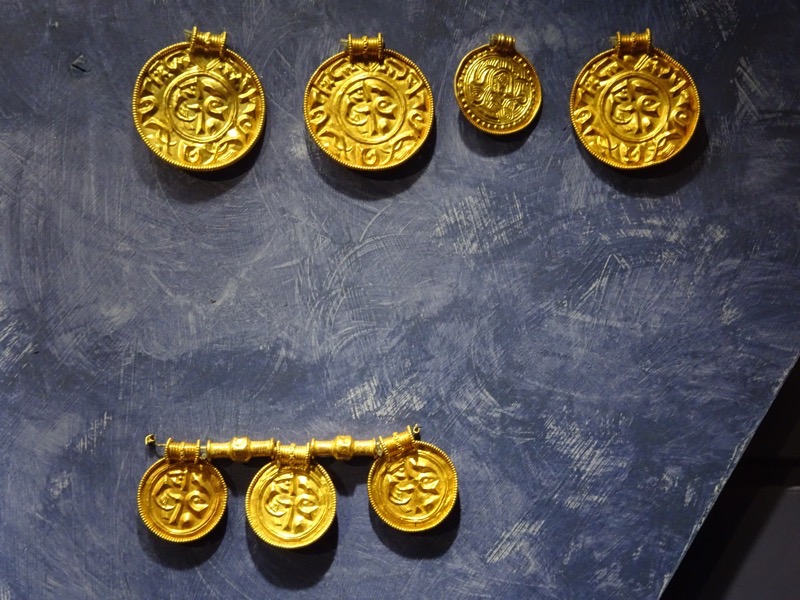


 And on the way out – back to the chaos.
And on the way out – back to the chaos. After this we went back to town, did a bit of proper touristing… you know, cruised the souvenir shops, stopped for a pint at the Dr Jeckyll pub, walked along the waterfront and checked out the multi-cultural festival being held in Oslo’s town centre. From there it was back to the ship! 🙂
After this we went back to town, did a bit of proper touristing… you know, cruised the souvenir shops, stopped for a pint at the Dr Jeckyll pub, walked along the waterfront and checked out the multi-cultural festival being held in Oslo’s town centre. From there it was back to the ship! 🙂
 I got to go first – and I have to say the most nerve wracking bit about this whole thing was the weigh in before we started! After three months on a cruise ship I was seriously concerned, but am happy to report that I have actually gone DOWN a few kilos thanks to all my incessant walking around the ship. I’ve been averaging about 9-11km per day just cracking laps of the corridors and decks and thankfully between that an zumba workouts, I have managed to avoid that dreaded cruise ship phenomena where all your clothes shrink! I’m quite happy with my wash – it’s not easy to say no to all the delicious food that is constantly (and I mean, CONSTANTLY) in front of you. Being a stubborn and pigheaded individual isn’t all bad it would seem.
I got to go first – and I have to say the most nerve wracking bit about this whole thing was the weigh in before we started! After three months on a cruise ship I was seriously concerned, but am happy to report that I have actually gone DOWN a few kilos thanks to all my incessant walking around the ship. I’ve been averaging about 9-11km per day just cracking laps of the corridors and decks and thankfully between that an zumba workouts, I have managed to avoid that dreaded cruise ship phenomena where all your clothes shrink! I’m quite happy with my wash – it’s not easy to say no to all the delicious food that is constantly (and I mean, CONSTANTLY) in front of you. Being a stubborn and pigheaded individual isn’t all bad it would seem. Mick, John and Terry looking like The Right Stuff… couldn’t get them walking through an airplane hanger, but you get the idea. 🙂
Mick, John and Terry looking like The Right Stuff… couldn’t get them walking through an airplane hanger, but you get the idea. 🙂  Barry and Sandie all suited up and ready for their big jump.
Barry and Sandie all suited up and ready for their big jump.

 yale getting ready to jump – not surprisingly they didn’t have a jumpsuit that fit him… sexy ankles there babe! 😛
yale getting ready to jump – not surprisingly they didn’t have a jumpsuit that fit him… sexy ankles there babe! 😛 

 After our adrenaline fuelled the lovely Chantelle/Christine took us to a seedy Irish pub for drinks and laughs all round – all up a great day was had by all. I’m going to miss all my Nookie friends when we all get off the ship in Sydney… only a few days left. So we shall have to fit in all the shenanigans before we debark! 🙂
After our adrenaline fuelled the lovely Chantelle/Christine took us to a seedy Irish pub for drinks and laughs all round – all up a great day was had by all. I’m going to miss all my Nookie friends when we all get off the ship in Sydney… only a few days left. So we shall have to fit in all the shenanigans before we debark! 🙂


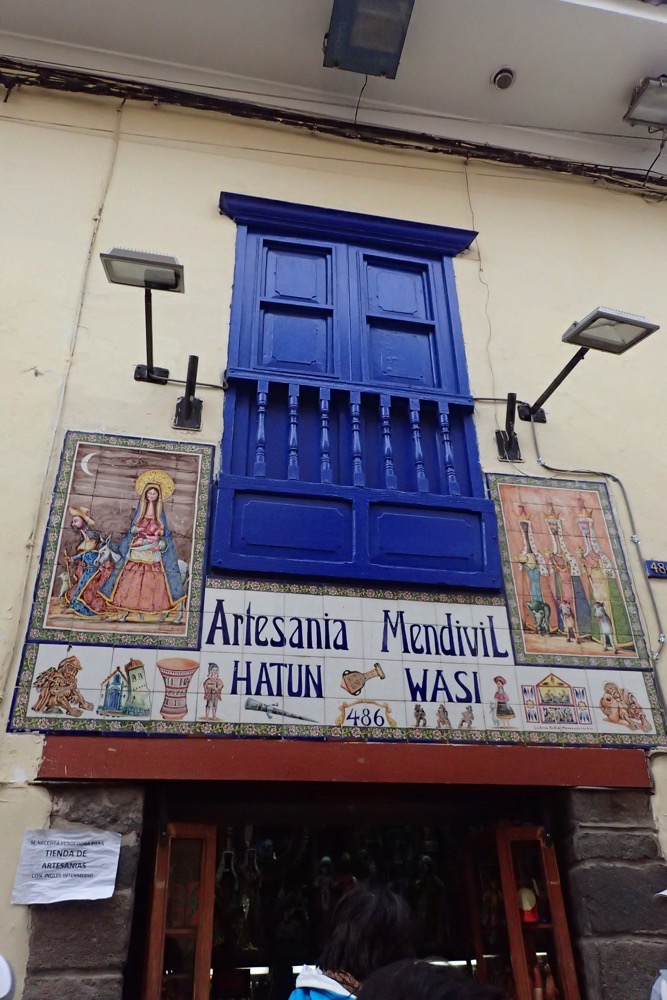


 The Square of the Warrior…
The Square of the Warrior…
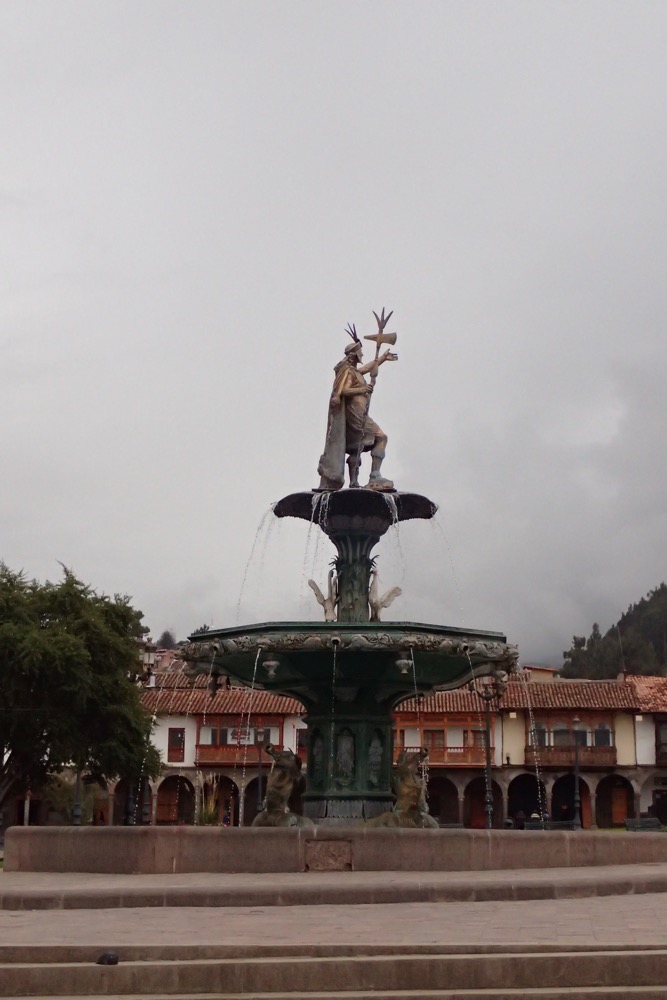




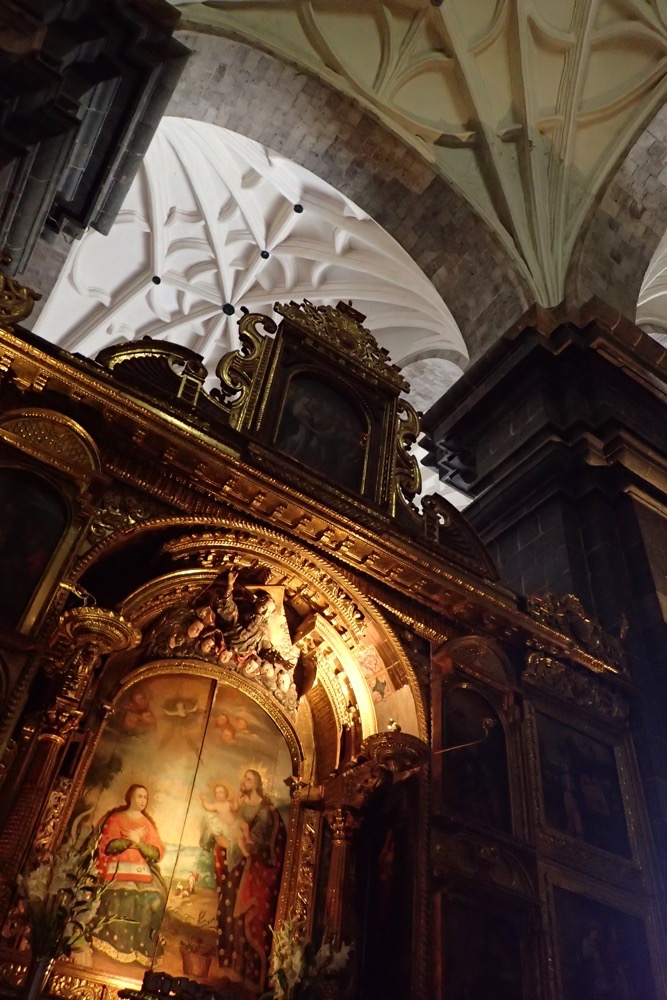






 The Spanish Cusco school of art…
The Spanish Cusco school of art…

 The Moon chamber – that was once covered in sheets of gold.
The Moon chamber – that was once covered in sheets of gold. Spanish arches evident that were built above the Inka stonework.
Spanish arches evident that were built above the Inka stonework. Niches in the Inca walls are quite common – this temple has these black lines (possibly painted with blood) running across the stonework at about heat height – the origin and purpose of the lines are unknown.
Niches in the Inca walls are quite common – this temple has these black lines (possibly painted with blood) running across the stonework at about heat height – the origin and purpose of the lines are unknown. When the Spanish plundered Quirkancha, they damaged much of the ancient stonework – this section of split open rock shows how precisely the stones fit together.
When the Spanish plundered Quirkancha, they damaged much of the ancient stonework – this section of split open rock shows how precisely the stones fit together. A replica of the Sun God disc… it is full of symbology representing the beliefs of the Inka people and elements of their world that carried great import. Sun, Moon, Ocean, Lakes, the Milky Way, the Southern Cross, Pumas, rainbows, the earthly world, man, woman, homes – this item is full of important iconography.
A replica of the Sun God disc… it is full of symbology representing the beliefs of the Inka people and elements of their world that carried great import. Sun, Moon, Ocean, Lakes, the Milky Way, the Southern Cross, Pumas, rainbows, the earthly world, man, woman, homes – this item is full of important iconography.
 The Milky Way with important Inka recontextualizations – images of llamas are evident in this painting.
The Milky Way with important Inka recontextualizations – images of llamas are evident in this painting.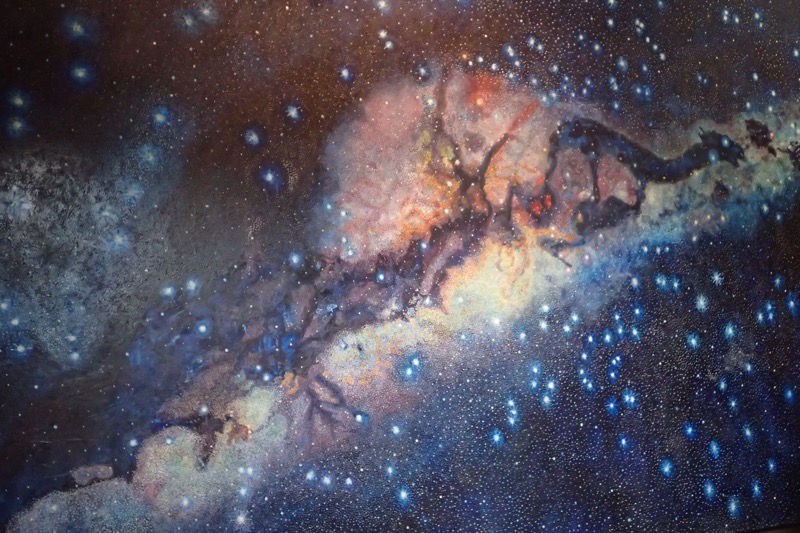 More Spanish archways evident above the Inka stonework. Cusco experienced an earthquake in 1950s and much of the Spanish construction was damaged – but the Inka work survived in tact.
More Spanish archways evident above the Inka stonework. Cusco experienced an earthquake in 1950s and much of the Spanish construction was damaged – but the Inka work survived in tact. View over Cusco from Quirkancha.
View over Cusco from Quirkancha.
 The water space
The water space
 Symmetry and alignment in the stonework windows…
Symmetry and alignment in the stonework windows… The tiniest ever found, Inka stonework block – about the size of a 10c piece.
The tiniest ever found, Inka stonework block – about the size of a 10c piece.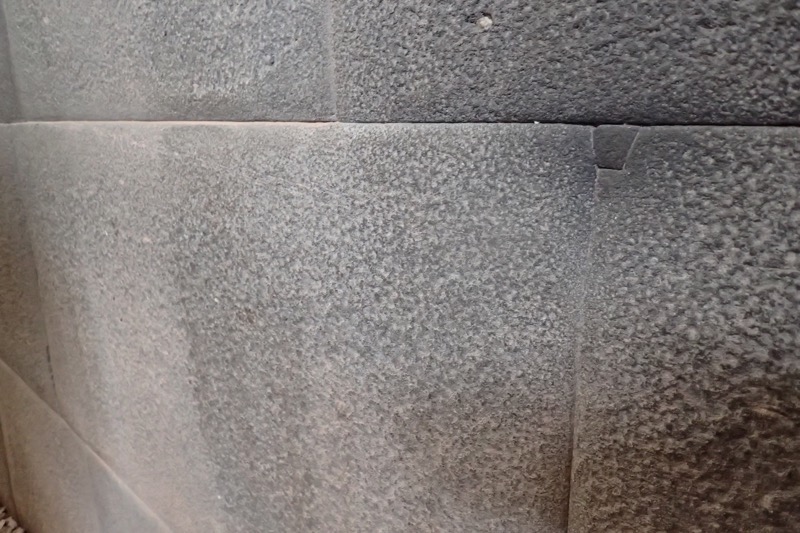 The mosaic on the back of the Cusco fountain where the two rivers meet.
The mosaic on the back of the Cusco fountain where the two rivers meet.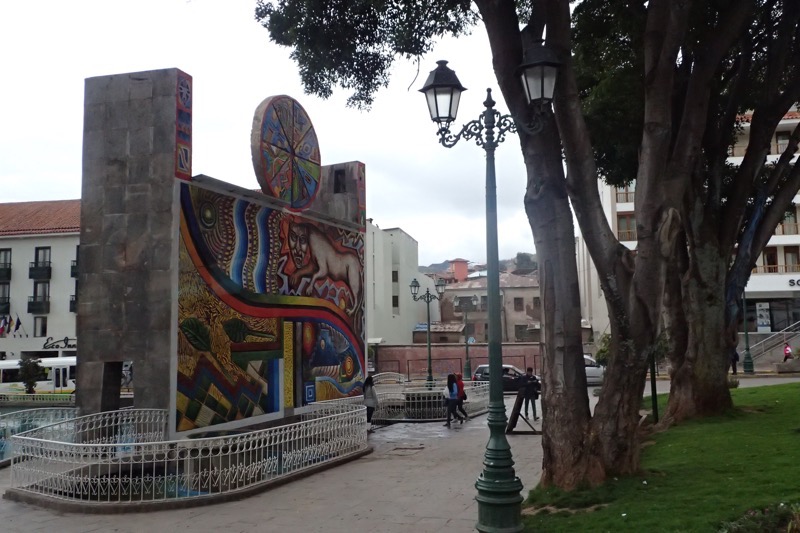 The first train to take people from Ollantaytambo to Aguas Callientes.
The first train to take people from Ollantaytambo to Aguas Callientes.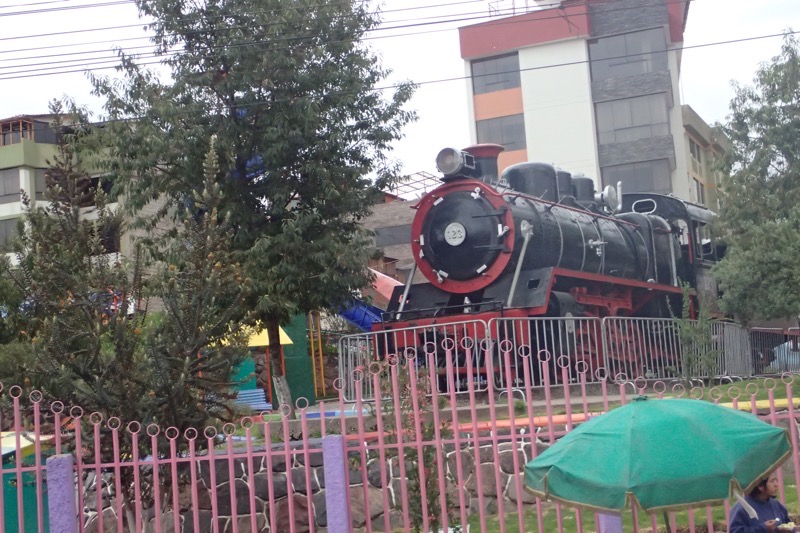





 Our fearless leader, Jaime…
Our fearless leader, Jaime…







 Most archeologists agree that Machu Pichhu is a 15th century Inka city that was built as a royal retreat for the Inka King, Pachacutek. It was often called the “Lost City of the Incas”, though that name was more usually applied to the Inka city of Vilcabama. Vilcabama, by the way, is the town that Hiram Bingham (an American historian and explorer) was looking for when he stumbled on Machu Picchu with the help of a small local boy in 1911.
Most archeologists agree that Machu Pichhu is a 15th century Inka city that was built as a royal retreat for the Inka King, Pachacutek. It was often called the “Lost City of the Incas”, though that name was more usually applied to the Inka city of Vilcabama. Vilcabama, by the way, is the town that Hiram Bingham (an American historian and explorer) was looking for when he stumbled on Machu Picchu with the help of a small local boy in 1911. Over the centuries the natural jungle overtook the site and very few outsiders knew of its existence leading to it being hidden from the world for over 400 years. The story goes that Yale University lecturer, Hiram Bingham was travelling the region looking for the “Lost Inca City” called Vilcabamba and an 8 year old boy said, (paraphrased of course) ‘I know a lost city in the mountains’, and the child took him to Machu Picchu. It wasn’t what he was looking for – but it was equally important. Bingham then arranged several expeditions in 1912, 1914 and 1915 to start clearing the jungle and vegetation out of the site. Bingham’s exploration efforts eventually attracted push back by local authorities who were concerned about exploitation and foreign intervention in this culturally significant site, so the excavation was taken over by local archeologists, but by this time many artefacts had been sent back to American institutions and reparation efforts are still ongoing.
Over the centuries the natural jungle overtook the site and very few outsiders knew of its existence leading to it being hidden from the world for over 400 years. The story goes that Yale University lecturer, Hiram Bingham was travelling the region looking for the “Lost Inca City” called Vilcabamba and an 8 year old boy said, (paraphrased of course) ‘I know a lost city in the mountains’, and the child took him to Machu Picchu. It wasn’t what he was looking for – but it was equally important. Bingham then arranged several expeditions in 1912, 1914 and 1915 to start clearing the jungle and vegetation out of the site. Bingham’s exploration efforts eventually attracted push back by local authorities who were concerned about exploitation and foreign intervention in this culturally significant site, so the excavation was taken over by local archeologists, but by this time many artefacts had been sent back to American institutions and reparation efforts are still ongoing.
 Luis giving us ALL the information – I am sure I have left out half of what he told us.
Luis giving us ALL the information – I am sure I have left out half of what he told us. The Temple of the Sun, Torreon, is a large tower that may have been used as an observatory or guard house – it is at the highest point in the complex and has impressive views down the valleys in every direction.
The Temple of the Sun, Torreon, is a large tower that may have been used as an observatory or guard house – it is at the highest point in the complex and has impressive views down the valleys in every direction. 
 It felt like we had been through a lot to get to this point…
It felt like we had been through a lot to get to this point…  The architecture of the town is adapted to the mountains by maximising the famous terrace system. The wide parallel terraces have been created around the central east-west open square for building and for agricultural purposes. The buildings are built out of white granite and designed to utilize this terrace spaces, and their agricultural practices were also designed around the restrictions the terraces provided. Each terrace has a metre of good earth on top, under which is a metre of riverbed sand (yes, they brought it all up the mountain from the river which is hundreds of metres below!), and under that is a metre of gravel on top of the bedrock. This construction of the terraces allowed for excellent irrigation, drainage and filtration of the water system that flows through the mountain town.
The architecture of the town is adapted to the mountains by maximising the famous terrace system. The wide parallel terraces have been created around the central east-west open square for building and for agricultural purposes. The buildings are built out of white granite and designed to utilize this terrace spaces, and their agricultural practices were also designed around the restrictions the terraces provided. Each terrace has a metre of good earth on top, under which is a metre of riverbed sand (yes, they brought it all up the mountain from the river which is hundreds of metres below!), and under that is a metre of gravel on top of the bedrock. This construction of the terraces allowed for excellent irrigation, drainage and filtration of the water system that flows through the mountain town. 



 I know – so many photos, but I just couldn’t pick the ‘best ones’.
I know – so many photos, but I just couldn’t pick the ‘best ones’.


 The pathways throughout the complex were made of stone like this, it was uneven and you had to be careful, but we were very grateful that it wasn’t also wet.
The pathways throughout the complex were made of stone like this, it was uneven and you had to be careful, but we were very grateful that it wasn’t also wet.








 The white granite that the 200 odd buildings of the complex are built with is all quarried right here on the top of the mountain. There are sections of the site that show that construction was still on going when the inhabitants decided to abandon the city.
The white granite that the 200 odd buildings of the complex are built with is all quarried right here on the top of the mountain. There are sections of the site that show that construction was still on going when the inhabitants decided to abandon the city. This building is a typical servant or commoner’s residence, in the Popular or Residential district of the site – it would have been a two story building, with a living, cooking and sleeping area downstairs, and a cool ventilated food storage area in the attic style roof.
This building is a typical servant or commoner’s residence, in the Popular or Residential district of the site – it would have been a two story building, with a living, cooking and sleeping area downstairs, and a cool ventilated food storage area in the attic style roof.


 The Temple of the Sun is part of the royalty area set out for the nobility, it features trapezoid shaped rooms and a Royal Tomb. The interior was used for sacred rites and/or sacrifices and you can see it was more finely constructed than the servants/slave/commoner buildings.
The Temple of the Sun is part of the royalty area set out for the nobility, it features trapezoid shaped rooms and a Royal Tomb. The interior was used for sacred rites and/or sacrifices and you can see it was more finely constructed than the servants/slave/commoner buildings. Inside the Royal Tomb is a three tiered rock, which is representative of the three Inka worlds, which are: the earthly world, often depicted as a puma, the underworld, associated with a snake, and the spirit world which is represented by the condor.
Inside the Royal Tomb is a three tiered rock, which is representative of the three Inka worlds, which are: the earthly world, often depicted as a puma, the underworld, associated with a snake, and the spirit world which is represented by the condor.

 The different areas of the site can be distinguished by the quality of the Inca stonework construction in each building. All the central buildings use the classical Inca architectural style of dry stone walls of regular shapes fitted tightly together. There are varying levels of workmanship evident in the stonework, varying from the rougher ‘rustic’ style which did use mortar…
The different areas of the site can be distinguished by the quality of the Inca stonework construction in each building. All the central buildings use the classical Inca architectural style of dry stone walls of regular shapes fitted tightly together. There are varying levels of workmanship evident in the stonework, varying from the rougher ‘rustic’ style which did use mortar… To a finer, ‘noble’ level of workmanship which appears on the priest and nobles residences and is dry stone…
To a finer, ‘noble’ level of workmanship which appears on the priest and nobles residences and is dry stone… To the near precision perfect ‘imperial’ style of stonework, that is so perfect there isn’t even gaps for a piece of paper..
To the near precision perfect ‘imperial’ style of stonework, that is so perfect there isn’t even gaps for a piece of paper..

 The Main Temple is dedicated to the Earthly world, which the Inka believe is represented by the Puma. This was a sacred place of ritual and sacrifice, and it is built with the same typical Inka stonework techniques. They used heavy large stones in a trapezoidal shape that lean inwards, and this construction is very stable – however this particular building has subsided on one corner where the edge of the building was supported by earth and not bedrock, which over time, has resulted in damage.
The Main Temple is dedicated to the Earthly world, which the Inka believe is represented by the Puma. This was a sacred place of ritual and sacrifice, and it is built with the same typical Inka stonework techniques. They used heavy large stones in a trapezoidal shape that lean inwards, and this construction is very stable – however this particular building has subsided on one corner where the edge of the building was supported by earth and not bedrock, which over time, has resulted in damage.
 The Inti Watana Stone – ‘inti’ meaning ‘sun’, ‘wata’ meaning ‘to tie up or hitch’; Inti Watana literally meaning, ‘a stone or place to tie up the sun’. In English it is often called the ‘Hitching Post of the Sun’ and more often called the ‘Sun Dial Stone’; it is one of the many ritual stones on this site. It is arranged to point directly at the sun during the winter solstice, at which time it casts no shadow whatsoever. The Inka believed the stone held the sun in its proper spot on its annual movement across the sky.
The Inti Watana Stone – ‘inti’ meaning ‘sun’, ‘wata’ meaning ‘to tie up or hitch’; Inti Watana literally meaning, ‘a stone or place to tie up the sun’. In English it is often called the ‘Hitching Post of the Sun’ and more often called the ‘Sun Dial Stone’; it is one of the many ritual stones on this site. It is arranged to point directly at the sun during the winter solstice, at which time it casts no shadow whatsoever. The Inka believed the stone held the sun in its proper spot on its annual movement across the sky.
 The Sacred Stone is so shaped to mirror and honour the mountain of the same shape which is directly behind it from this vantage point – unfortunately today, the mountain is hidden in the ‘cloud forest’. Offerings and small sacrifices to the mountains were often made at this stone.
The Sacred Stone is so shaped to mirror and honour the mountain of the same shape which is directly behind it from this vantage point – unfortunately today, the mountain is hidden in the ‘cloud forest’. Offerings and small sacrifices to the mountains were often made at this stone. Luis, our expert guide, Jaime, our super friendly, ultra organised travel guru, and some of our now weary, but very happy hikers.
Luis, our expert guide, Jaime, our super friendly, ultra organised travel guru, and some of our now weary, but very happy hikers. The Temple of the Condor – the large diagonal stonework represents the wings of the condor, and the stone in the ground, it’s head. It is a rather small spot in the site, and it was difficult to get a photograph that displayed the condor outline well… this temple honours the spirit world, that the Inka people aspired to ascend to.
The Temple of the Condor – the large diagonal stonework represents the wings of the condor, and the stone in the ground, it’s head. It is a rather small spot in the site, and it was difficult to get a photograph that displayed the condor outline well… this temple honours the spirit world, that the Inka people aspired to ascend to.  As we were moving around these lower terraces which held all the commoner housing and the Temple of the Condor, the clouds had started to roll back in and we had a bit of light rain occasionally… I for one, was really appreciating the beautiful, moody weather – it somehow seemed perfectly suited to this sacred site.
As we were moving around these lower terraces which held all the commoner housing and the Temple of the Condor, the clouds had started to roll back in and we had a bit of light rain occasionally… I for one, was really appreciating the beautiful, moody weather – it somehow seemed perfectly suited to this sacred site. Just as we were exiting the site feeling exhilarated and energised, and for some of us a sense of achievement we didn’t think was possible – the clouds started to roll in properly and the rain went from sporadic moments of drizzle, to us pulling out all the wet weather gear. The timing could not have been more fortuitous – perhaps the Inka Sun God was smiling on us this morning.
Just as we were exiting the site feeling exhilarated and energised, and for some of us a sense of achievement we didn’t think was possible – the clouds started to roll in properly and the rain went from sporadic moments of drizzle, to us pulling out all the wet weather gear. The timing could not have been more fortuitous – perhaps the Inka Sun God was smiling on us this morning.




 On the wall in the restaurant where we were having a drink – I saw this most bizarre artwork… it appears to be Jesus Christ in front of Machu Picchu surrounded by disciples, at the Last Supper, but on closer inspection, it is Jesus Christ, in front of Machu Picchu, surrounded by the 14 Inca Kings! Just a fantastical blend of cultures and beliefs in this bas relief artwork – I had to share it here so I wouldn’t forget it. Completely bizarre!
On the wall in the restaurant where we were having a drink – I saw this most bizarre artwork… it appears to be Jesus Christ in front of Machu Picchu surrounded by disciples, at the Last Supper, but on closer inspection, it is Jesus Christ, in front of Machu Picchu, surrounded by the 14 Inca Kings! Just a fantastical blend of cultures and beliefs in this bas relief artwork – I had to share it here so I wouldn’t forget it. Completely bizarre!
 Next we were off to the train station to head back to Ollantaytambo.
Next we were off to the train station to head back to Ollantaytambo. We had a ‘special carriage’ on the way back – again with the aerial dome roof to enjoy the view, which was magnificent, but this train trip also came with snacks, drinks, dancing and a fashion parade. It was a fun light hearted way to finish a magnificent day. 🙂
We had a ‘special carriage’ on the way back – again with the aerial dome roof to enjoy the view, which was magnificent, but this train trip also came with snacks, drinks, dancing and a fashion parade. It was a fun light hearted way to finish a magnificent day. 🙂 
 The views were amazing, and plenty of Inka ruins were visible out the windows on the ride.
The views were amazing, and plenty of Inka ruins were visible out the windows on the ride. The city of Machu Picchu sits on a saddle between two mountains, the larger Machu Picchu mountain and the smaller Huayna Picchu (pronounced Wayna Picchu) – Machu Picchu literally means ‘older mountain’, while Huayna Picchu translates to ‘younger mountain’. While we were on the site – we could see adventurous climbers trekking up Huayna Picchu to get a different view of the sacred city.
The city of Machu Picchu sits on a saddle between two mountains, the larger Machu Picchu mountain and the smaller Huayna Picchu (pronounced Wayna Picchu) – Machu Picchu literally means ‘older mountain’, while Huayna Picchu translates to ‘younger mountain’. While we were on the site – we could see adventurous climbers trekking up Huayna Picchu to get a different view of the sacred city.
 Bing’s photos from Huayna Picchu:
Bing’s photos from Huayna Picchu:
 And when the clouds lifted entirely – the view is nothing short of spectacular! When (not if!), *when* I come back to South America, and to Machu Picchu, I would love to try and climb Huayna Picchu – even if it takes me an entire day. It is simply amazing.
And when the clouds lifted entirely – the view is nothing short of spectacular! When (not if!), *when* I come back to South America, and to Machu Picchu, I would love to try and climb Huayna Picchu – even if it takes me an entire day. It is simply amazing. 
 The train entertainment – I am not sure who this guy represents or what his dance signified, but he was a whirlwind of upbeat music, clapping hands and colourful costume. This blurry mess of a picture very much captures the moment in my humble opinion. 😉
The train entertainment – I am not sure who this guy represents or what his dance signified, but he was a whirlwind of upbeat music, clapping hands and colourful costume. This blurry mess of a picture very much captures the moment in my humble opinion. 😉 
 After the dancing, there was a fashion parade as our waitstaff donned some of the lovely alpaca textiles that the region is famous for and showed us many different ways to wear a humble poncho or serape. Lovely stuff, but we had already filled our bags beyond capacity!
After the dancing, there was a fashion parade as our waitstaff donned some of the lovely alpaca textiles that the region is famous for and showed us many different ways to wear a humble poncho or serape. Lovely stuff, but we had already filled our bags beyond capacity!  Finally we arrived back to Ollantaytambo (and yes, I keep writing that O-Place down in this blog in the hope it will solidify in my brain and I will remember it without having to reach for it!), and we then had a one and a half hour drive back to Cusco. While many of our group took the opportunity to have a nap on the bus – I was the crazy lady on the bus balancing an iPad on a backpack/desk, attempting to write all this down before the sequence of events ended up muddled into yesterday or tomorrows sights. So far, I think I’ve done an okay fist of it – but there’s probably plenty of room for improvement!
Finally we arrived back to Ollantaytambo (and yes, I keep writing that O-Place down in this blog in the hope it will solidify in my brain and I will remember it without having to reach for it!), and we then had a one and a half hour drive back to Cusco. While many of our group took the opportunity to have a nap on the bus – I was the crazy lady on the bus balancing an iPad on a backpack/desk, attempting to write all this down before the sequence of events ended up muddled into yesterday or tomorrows sights. So far, I think I’ve done an okay fist of it – but there’s probably plenty of room for improvement! We had a bit of a wander to find our B&B… We were staying at the San Blas Boutique Hotel in the San Blas region of the city. It is a lovely part of town full of restaurants and bars, but we were all so exhausted after such a big day, that we took advantage of good quality beds, lovely big warm comforters, and (would you believe it? what a lovely touch) hot water bottles all round, and everyone went to sleep early.
We had a bit of a wander to find our B&B… We were staying at the San Blas Boutique Hotel in the San Blas region of the city. It is a lovely part of town full of restaurants and bars, but we were all so exhausted after such a big day, that we took advantage of good quality beds, lovely big warm comforters, and (would you believe it? what a lovely touch) hot water bottles all round, and everyone went to sleep early.
